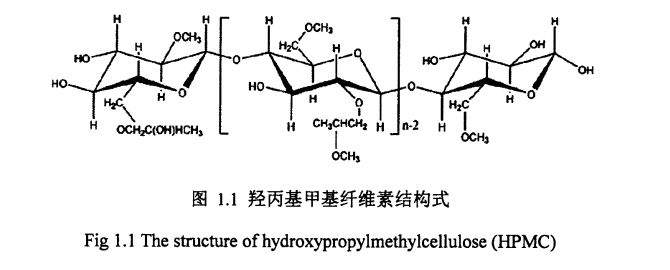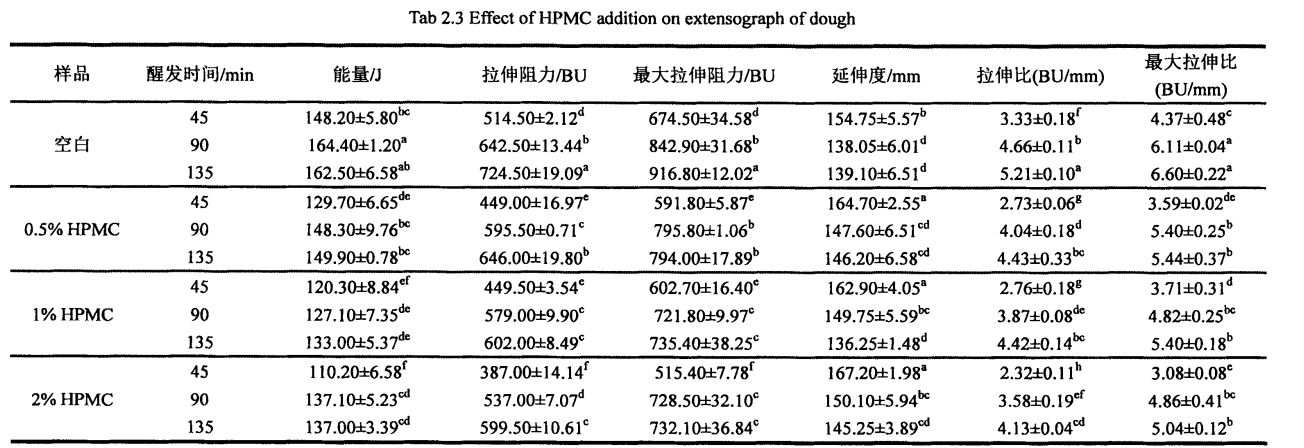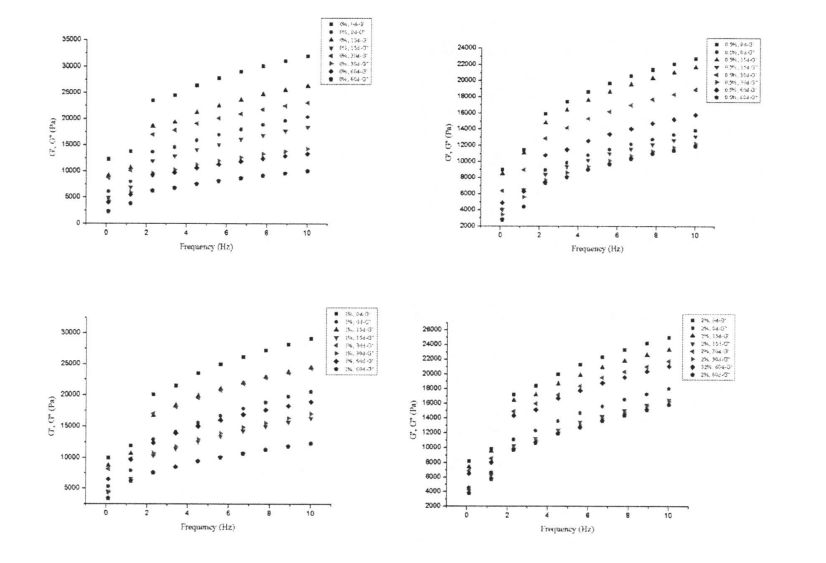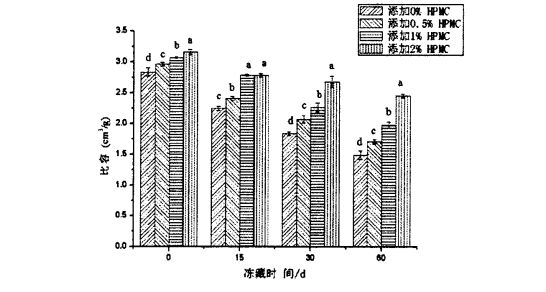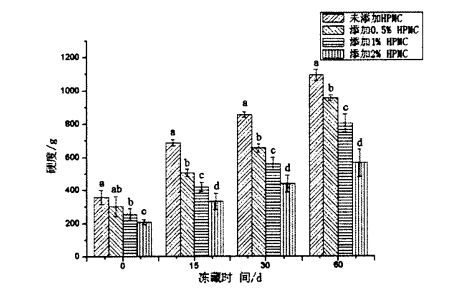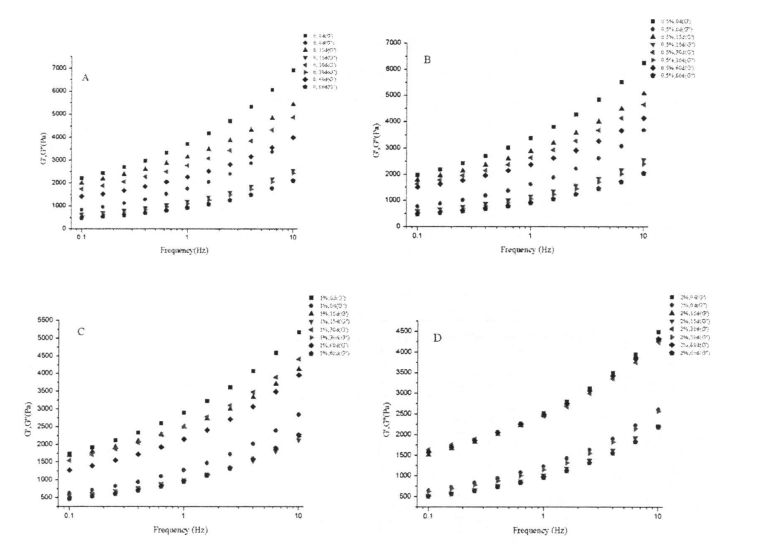Zotsatira zoyeserera komanso zotambalala zinawonetsa kuti kuwonjezera kwa hpmc mokwanira pokonzekera mtandawo, ndipo zida zaphokoso kwambiri zimawonetsa kuti mapuluwo amasintha pang'ono, ndipo mawonekedwe a mtanda adakhazikika. In addition, compared with the control group, the specific volume and elasticity of the steamed bread were improved, and the hardness was reduced after the frozen dough added with 2% HPMC was frozen for 60 days.
Wheat gluten is the material basis for the formation of dough network structure. Kuyesa kwapezeka kuti kuwonjezera kwa i - ipmc kunachepetsa kuwonongeka kwa yd ndikuchotsa mapuloteni a tirigu pakati pa mapuloteni ozizira. In addition, the results of low-field nuclear magnetic resonance and differential scanning the water state transition and recrystallization phenomena are limited, and the content of freezable water in the dough is reduced, thereby suppressing the effect of ice crystal growth on the gluten microstructure and its spatial conformation. Scanning ma microscopes akuwonetsa mwachisawawa kuti kuwonjezera kwa HPMC kumatha kukhalabe ndi mawonekedwe a ma rtiten.
Starch is the most abundant dry matter in dough, and changes in its structure will directly affect the gelatinization characteristics and the quality of the final product. X. The results of X-ray diffraction and DSC showed that the relative crystallinity of starch increased and the gelatinization enthalpy increased after frozen storage. Ndi nthawi yopumira yosungirako, mphamvu yotupa ya wowuma popanda kuphatikizidwa kwa HPMC idachepa pang'onopang'ono, pomwe mamasukidwe ochepera, mtengo wocheperako komanso mtengo wobwereza boti. Munthawi yosungirako, poyerekeza ndi gulu lowongolera, ndikuchulukitsa kwa HPMC, kusintha kwa kapangidwe ka stilat grastal kupanga pang'onopang'ono kunachepa.
M'ndandanda wazopezekamo
1.1.5 Kafukufuku wofufuza za mtanda wambiri ....................... ...........................................
1.1.7 Hydroxypropyl methyl cellulose (Hydroxypropyl methyl cellulose, I-IPMC) ………. 5
2.3 Experimental results and discussion…………………………………………………………………… . 11
2.3.5 Zotsatira za Kuchulukitsa kwa HPMC ndi nthawi yosungirako kwa madzi ozizira (GW) mu mtanda wozizira ...............................................................................
2.3.6 Mphamvu ya Kuchulukitsa Kwa HPMC ndi nthawi yozizira pamtundu wa mkate wobiriwira .............................
Njira 3.2.4 Njira zoyesera ................................................................................................................. 25
3.3.2 The effect of adding amount of HPMC and freezing storage time on the freezable moisture content (CFW) and thermal stability……………………………………………………………………. 30
3.3.3 Effects of HPMC addition amount and freezing storage time on free sulfhydryl content (C vessel) …………………………………………………………………………………………………………. . 34
34 Chidule cha Chidule .......................................................
4.1 Introduction .............................................................................................................................. . 44
4.2 Experimental materials and methods ................................................................................. 45
4.2.1 Zipangizo zoyesera .............................................................................................. .45
4,2.2 Zoyesera zoyesera ...............................................
4.3 Analysis and discussion ........................................................................................................... 48
4.3.1 Content of basic components of wheat starch ……………………………………………………. 48
4,3.2 zokhudzana ndi I-IPMC zowonjezera ndi nthawi yopumira pa gelatinization wa gelatinization ya tirigu wa tirigu wa Wheet .................................................................................. .48
4.3.3 Effects of HPMC addition and freezing storage time on the shear viscosity of starch paste………………………………………………………………………………………………………………………………………. 52
4.3.6 Effects of I-IPMC addition amount and frozen storage time on the thermodynamic properties of starch ………………………………………………………………………………………………………. . 57
Chapter 5 Effects of HPMC addition on yeast survival rate and fermentation activity under frozen storage conditions………………………………………………………………………………………………. . 62
5.1Introduction .................................................................................................................................... 62
5.2 Materials and methods ............................................................................................................ 62
5.2.2 Experimental methods . . . . . …………………………………………………………………………. 63
5.3 Results and Discussion ............................................................................................................... 64
5.3.3 The effect of adding amount of HPMC and freezing time on the content of glutathione in dough……………………………………………………………………………………………………………66. "
5.4 Chaputala Chidule ............................................................................................................ 67
6.1 Conclusion ................................................................................................................................. . 68
6.2 Outlook .......................................................................................................................................... 68
Figure 1.1 The structural formula of hydroxypropyl methylcellulose………………………. . 6
Chithunzi 2.1
Chithunzi 2.2 zotsatira za kuwonjezera kwa HPMC ndi nthawi yozizira pa kuchuluka kwa mkate wobiriwira .............
Figure 2.4 The effect of HPMC addition and freezing time on the elasticity of steamed bread………………………………………………………………………………………………………………………………. . 20
Chithunzi 3.1 Zotsatira za Kuchulukitsa kwa HPMC ndi nthawi yozizira pazakudya zonyowa ..................... 30
Figure 3.2 Effects of HPMC addition and freezing time on the thermodynamic properties of wheat gluten………………………………………………………………………………………………………………. . 34
Figure 3.3 Effects of HPMC addition and freezing time on free sulfhydryl content of wheat gluten……………………………………………………………………………………………………………………………... . 35
Figure 3.7 The effect of HPMC addition and freezing time on the microscopic gluten network structure…………………………………………………………………………………………………………... . 43
Figure 4.1 Starch gelatinization characteristic curve ............................................................... 51
Figure 4.2 Fluid thixotropy of starch paste ................................................................................. 52
Figure 4.3 Effects of adding amount of MC and freezing time on the viscoelasticity of starch paste……………………………………………………………………………………………………………………... . 57
Figure 4.5 Effects of HPMC addition and freezing storage time on the thermodynamic properties of starch…………………………………………………………………………………………………………. . 59
Figure 5.2 The effect of HPMC addition and freezing time on the yeast survival rate…………………………………………………………………………………………………………………………………... . 67
Figure 5.3 Microscopic observation of yeast (microscopic examination) …………………………………………………………………………………………………………………………. 68
Table 2.1 The basic ingredient content of wheat flour…………………………………………………. 11
Gawo la 2.4 Zotsatira za I-IPMC Zowonjezera ndi nthawi yozizira (ntchito ya CF) ya mtanda wowundana ...............
Table 3.2 Effects of I-IPMC addition amount and freezing storage time on the phase transition enthalpy (Yi IV) and freezer water content (e chat) of wet gluten………………………. 31
Table 3.3 Effects of HPMC addition amount and freezing storage time on the peak temperature (product) of thermal denaturation of wheat gluten…………………………………………. 33
Table 3.6 Effects of I-IPMC addition and freezing storage time on the surface hydrophobicity of wheat gluten……………………………………………………………………………………………. 41
Zowonjezera 4.3 zotsatira za I-IPMC Kuchulukitsa kwa Ismc ndikuzizira pakukweza kwa tirigu wa tirigu wowoneka bwino ............... 55
Steamed bread refers to the food made from the dough after proofing and steaming. Monga chinenerochi chachi China, pasitala yacikhalidwe, imakhala ndi mbiri yakale ndipo imadziwika kuti "mkate wamatsenga". Chifukwa chomaliza chomalizidwa ndi hemispherical kapena kutalika kwake, chofewa pakumva kukoma, chokoma pola ndi michere yambiri kwa nthawi yayitali. Ndi chakudya chopanda tanthauzo cha dziko lathu, makamaka anthu akumpoto. Maakaunti ogwiritsa ntchito pafupifupi 2/3 yazakudya zamagulu a zinthu kumpoto, ndipo pafupifupi 46% yazakudya zamagulu a ubongo mdziko muno [[Chithunzi patsamba [21].
1)Development of new characteristic steamed buns. Through the innovation of steamed bread raw materials and the addition of functional active substances, new varieties of steamed breads have been developed, which have both nutrition and function. Adakhazikitsa muyeso wounikana chifukwa cha kuchuluka kwa mkate wopingasa wokhazikika ndi kafukufuku wamkulu; Fu et a1. (2015) added lemon pomace containing dietary fiber and polyphenols to steamed bread, and evaluated the antioxidant activity of steamed bread; Hao & Beta (2012) studied barley bran and flaxseed (rich in bioactive substances) The production process of steamed bread [5]; Shiau et A1. .
2) Kafukufuku pa kukonza ndikuphatikiza ufa wapadera wa mkate wobiriwira. The effect of flour properties on the quality of dough and steamed buns and the research on new special flour for steamed buns, and based on this, an evaluation model of flour processing suitability was established [7]; for example, the effects of different flour milling methods on the quality of flour and steamed buns[7] 81; Zotsatira za kuchuluka kwa tirigu zingapo zimayika pamtundu wa mkate wobiriwira [9J et al.; Zhung, huang, & Khan (2001) adayesedwa zotsatira za pulojekiti ndi kumpoto, ndikuganiziridwa kuti Gliannin / Glutenin adachita mosavuta kwambiri ndi malo obiriwira [a]]; Zhang, et a1. . have a significant impact [11].
3)Research on dough preparation and steamed bread making technology. Research on the influence of steamed bread production process conditions on its quality and process optimization; Liu Changwang et al. (2009) showed that in the process of dough conditioning, process parameters such as water addition, dough mixing time, and dough pH value have an impact on the whiteness value of steamed bread. Imakhala ndi mphamvu yofunika kwambiri pankhani yowunikira. Ngati njirayi siyabwino, ipangitsa kuti malonda atembenuke buluu, wakuda kapena wachikasu. The research results show that during the dough preparation process, the amount of water added reaches 45%, and the dough mixing time is 5 minutes, ~ When the pH value of the dough was 6.5 for 10 min, the whiteness value and sensory evaluation of the steamed buns measured by the whiteness meter were the best. Mukamagudubuza pa mtanda 15-20 nthawi imodzi, mtanda ndi wowoneka bwino, wosalala, wonyezimira komanso wonyezimira; Gawo logudubuka ndi 3: 1, pepala la mtanda limanyezimira, ndipo kuyeta kwa mkate wobiriwira kumachulukana. Li, et a1. .
4) Kafukufuku pa kusintha kwabwino kwa mkate wothiridwa. Kafukufuku wowonjezera ndi kugwiritsa ntchito kwa mikate yokhazikika; mainly including additives (such as enzymes, emulsifiers, antioxidants, etc.) and other exogenous proteins [14], starch and modified starch [15], etc. The addition and optimization of the corresponding process It is particularly noteworthy that in recent years, through the use of some exogenous proteins and other additives, gluten-free (free. gluten) pasta products have been developed to meet the requirements of celiac disease (Dietary needs of patients with Coeliac Disease [16.1 cit.
5) Kutetezedwa ndi anti-ukalamba wa mkate wokhazikika ndi njira zofananira. Pan Lijn et al. . Wang, et A1. . The results showed that water loss and starch recrystallization were the main reasons for the aging of steamed bread [20].
6) Kafukufuku pakugwiritsa ntchito mabakiteriya atsopano osokoneza bongo. Jiang, et A1. (2010) Application of Chaetomium sp. fermented to produce xylanase (with thermostable) in steamed bread [2l'; Gerez, et A1. (2012) used two kinds of lactic acid bacteria in fermented flour products and evaluated their quality [221; Wu, et al. . Ndipo Gerez, et A1. (2012) used the fermentation characteristics of two kinds of lactic acid bacteria to accelerate the hydrolysis of gliadin to reduce the allergenicity of flour products [24] and other aspects.
Mtanda wachisanu ndiukadaulo watsopano pakupanga ndikupanga mapangidwe a ufa opangidwa mu 1950s. It mainly refers to the use of wheat flour as the main raw material and water or sugar as the main auxiliary materials. Baked, packed or unpacked, quick-freezing and other processes make the product reach a frozen state, and in. For products frozen at 18"C, the final product needs to be thawed, proofed, cooked, etc. [251].
Kutuluka kwa mtanda wozizira osati kumangoyambitsa mikhalidwe yotayirira, kufikiridwa, ndi kupanga kanthawi kochepa pasitala, kumatha kufupikitsa nthawi yosinthira pasitala, kusintha bwino ntchito yopanga, ndikuchepetsa nthawi yopanga ndi ndalama. Therefore, the aging phenomenon of the pasta food is effectively inhibited, and the effect of prolonging the shelf life of the product is achieved. Therefore, especially in Europe, America, Japan and other countries, frozen dough is widely used in white bread (Bread), French Sweet Bread (French Sweet Bread), small muffin (muffin), bread rolls (Rolls), French baguette (- Stick), cookies and frozen
Cakes and other pasta products have different degrees of application [26-27]. According to incomplete statistics, by 1990, 80% of bakeries in the United States used frozen dough; 50% of bakeries in Japan also used frozen dough. Zaka 20
The frozen dough technology undoubtedly provides a feasible idea for the industrialized production of traditional Chinese food such as steamed bread. However, this processing technology still has some shortcomings, especially under the condition of longer freezing time, the final product will have longer proofing time, lower specific volume, higher hardness, Water loss, poor taste, reduced flavor, and quality deterioration. Kuphatikiza apo, chifukwa chozizira
Most studies have found that the formation and growth of ice crystals in frozen foods is an important factor leading to the deterioration of product quality [291]. Ice crystals not only reduce the survival rate of yeast, but also weaken the gluten strength, affect the starch crystallinity and gel structure, and damage the yeast cells and release the reducing glutathione, which further reduces the gas holding capacity of gluten. Kuphatikiza apo, pankhani ya kuzizira chosungira, kusinthasintha kwa kutentha kumatha kuyambitsa ma ayezi kuti akule chifukwa chobwezeretsanso [30]. Therefore, how to control the adverse effects of ice crystal formation and growth on starch, gluten and yeast is the key to solving the above problems, and it is also a hot research field and direction. In the past ten years, many researchers have been engaged in this work and achieved some fruitful research results. However, there are still some gaps and some unresolved and controversial issues in this field, which need to be further explored, such as:
a) Momwe mungalekerere kuwonongeka kwa mtanda wowundana ndi nthawi yowonjezera yophukira, makamaka momwe angalamulire kutengera kwa mapangidwe ndi katundu, gluten ndi yusiti), akadali ndi vuto. Hotspots and fundamental issues in this research field;
c) kukulitsa, thamangitsani ndikugwiritsa ntchito madzi owuma owundana owundana, zomwe zimapangitsa kuti mabizinesi opanga mabizinesi opanga ndi zomwe zathera ndalama ndi ndalama zowononga. At present, it still needs to be further strengthened and expanded;
I.Study zosintha mu kapangidwe kake ndi mtanda wowundana ndi nthawi yowonjezera yosungirako zinthu zachilengedwe, makamaka kuti muchepetse zifukwa zowonongeka pazinthu zamankhwala, makamaka zomwe zimayambitsa ayezi Formation and growth and its relationship with water state and distribution; changes in wheat gluten protein structure, conformation and properties [31]; kusintha kwa kapangidwe kazinthu komanso katundu; changes in dough microstructure and related properties, etc. 361.
Ii. Kuthana kwa mphamvu yozizira kupanga, malo osungira owundana ndi njira. Mukamapanga mtanda wachisanu, kuwongoleredwa kutentha, mikhalidwe yotsimikizika, yozizira ma protering, njira zozizira, komanso njira zonse zomwe zingasokoneze mawonekedwe a mtanda [37]. Mwambiri, mitengo yozizira kwambiri imatulutsa makhiristo ozizira omwe ndi ochepa kukula komanso kufalikira mosavuta, pomwe otsika ozizira amatulutsa ma crytes a icers akuluakulu omwe sakugawidwa mofatsa. In addition, a lower freezing temperature even below the glass transition temperature (CTA) can effectively maintain its quality, but the cost is higher, and the actual production and cold chain transportation temperatures are usually small. Kuphatikiza apo, kusinthasintha kwa kutentha kwa kutentha kumayambitsa rexcalization, zomwe zingakhudze mtanda.
Iii. Using additives to improve the product quality of frozen dough. In order to improve the product quality of frozen dough, many researchers have made explorations from different perspectives, for example, improving the low temperature tolerance of material components in frozen dough, using additives to maintain the stability of the dough network structure [45.56], etc. Among them, the use of additives is an effective and widely used method. Makamaka, i) enzyme kukonzekera, monga, exzgunaminase, o [. Amylase; ii) emulsifiers, such as monoglyceride stearate, DATEM, SSL, CSL, DATEM, etc.; iii) antioxidants, ascorbic acid, etc.; iv) polysaccharide hydrocolloids, such as guar gum, yellow Originalgum, gum Arabic, konjac gum, sodium alginate, etc.; v) Zinthu zina zogwirira ntchito, monga Xu, et A1. .
Ⅳ. Breeding of antifreeze yeast and application of new yeast antifreeze [58-59]. Sasano, et a1. .
The chemical nature of hydrocolloid is a polysaccharide, which is composed of monosaccharides (glucose, rhamnose, arabinose, mannose, etc.) through 0 [. 1-4. Glycosidic bond or/and a. 1 - "6. Glycosidic Bond kapena B. 1-4. Glycosidic Compound ndi 0 [.1-3. polysaccharides, such as konjac gum, guar gum, gum Arabic ; ③ seaweed polysaccharides, such as seaweed gum, carrageenan; ④ microbial polysaccharides, such as Xanthan gum .Polysaccharide has strong hydrophilicity because it contains a large number of hydroxyl groups that are easy to form hydrogen bonds with water, and has the functions of controlling the migration, state and distribution of water in the food system. Therefore, the addition of hydrophilic colloids gives food Many functions, properties, and qualities of hydrocolloids are closely related to the interaction between polysaccharides and water and other macromolecular substances. At the same time, due to the multiple functions of thickening, stabilizing, and water retention, hydrocolloids are widely used to include in the food processing of flour products. Wang xin et al. (2007) studied the effect of adding seaweed polysaccharides and gelatin on the glass transition temperature of dough [631. Wang Yusheng et al. (2013) believed that compound addition of a variety of hydrophilic colloids can significantly change the flow of dough. Change the properties, improve the tensile strength of the dough, enhance the elasticity of the dough, but reduce the extensibility of the dough [delete.
1.1.,5hydropypyl methy cellose (hydroxypropyl methyl celyolose, I-IPMC)
Due to the existence of hydrogen bonds in the linear molecular chain and crystalline structure, cellulose has poor water solubility, which also limits its application range. However, the presence of substituents on the side chain of HPMC breaks the intramolecular hydrogen bonds, making it more hydrophilic [66l], which can quickly swell in water and form a stable thick colloidal dispersion at low temperatures Tie. As a cellulose derivative-based hydrophilic colloid, HPMC has been widely used in the fields of materials, papermaking, textiles, cosmetics, pharmaceuticals and food [6 71]. Makamaka, chifukwa cha malo ake a thermo-gelling, hpmc nthawi zambiri amagwiritsidwa ntchito ngati gawo la kapisozi ka mankhwala osokoneza bongo; Mu chakudya, hpmc imagwiritsidwanso ntchito ngati chowonjezera, okumba, ma emulsifiers, okhazikika, ndi zina zowonjezera. For example, the addition of HPMC can change the gelatinization characteristics of starch and reduce the gel strength of starch paste. , HPMC can reduce the loss of moisture in food, reduce the hardness of bread core, and effectively inhibit the aging of bread.
Ngakhale HPMC yakhala ikugwiritsidwa ntchito pasitala pamlingo wina, amagwiritsidwa ntchito makamaka ngati wogwira ntchito yotsutsa mkate, ndi zina zowonjezera. Komabe, poyerekeza ndi ma hydrophilic ma colloids monga Guar chingamu, xanthan chingamu, ndi sodium chimakhala ndi malingaliro a mkate wa HPMC mu mtanda wowundana. There is still a lack of relevant reports on its effect.
At present, the application and large-scale production of frozen dough processing technology in my country as a whole is still in the development stage. At the same time, there are certain pitfalls and deficiencies in the frozen dough itself. Zinthu zonsezi mosakayikira zimalepheretsa ntchito ina ndi kukweza kwa mtanda wachisanu. Kumbali inayi, izi zikutanthauzanso kuti kugwiritsa ntchito mtanda wachisanu kuli ndi mwayi wabwino komanso wotakatakaza chakudya cham'madzi cham'madzi cham'madzi (osapanga zakudya zambiri zomwe zimakwaniritsa zosowa za anthu okhala ku China. It is of practical significance to improve the quality of the frozen dough based on the characteristics of Chinese pastry and the dietary habits, and is suitable for the processing characteristics of Chinese pastry.
Ndi chifukwa chakuti kafukufuku woyenera ntchito ya HPMC mu Zakudya zaku China zikuchepa. Therefore, the purpose of this experiment is to expand the application of HPMC to frozen dough, and to determine the improvement of frozen dough processing by HPMC through the evaluation of steamed bread quality. In addition, HPMC was added to the three main components of the dough (wheat protein, starch and yeast liquid), and the effect of HPMC on the structure and properties of wheat protein, starch and yeast was systematically studied. Ndipo mufotokozereni Makina ake okhudzana ndi Makina, kuti apereke njira yatsopano yochitira bwino za mtanda wambiri, kuti muwonjezere kuchuluka kwa HPMC muunda wa chakudya, ndikutipatsa chithandizo chochepa pakupanga mkate wowonda.
1) Sankhani mtundu watsopano wa hydrophilic colloid, hydroxypropyll methylcellulose (hpmc) monga wowonjezera, ndikuwerenga kuchuluka kwa HPMC yozizira (masiku 60) mikhalidwe. (0%, 0,5%, 1%, 2%; zofanana pansipa) HPMC pa ma processies a mtanda wachisanu;
4) Kuchokera pamakina oyendetsa bwino, zowonjezera za zowonjezera zosiyanasiyana za HPMC pa ntchito ya mphamvu, kupulumuka, komanso zowonjezera zowonjezera za yisiti yosungirako nthawi yozizira.
Generally speaking, the material composition of dough used for making fermented flour products mainly includes biological macromolecular substances (starch, protein), inorganic water, and yeast of organisms, and is formed after hydration, cross-linking and interaction. Dongosolo lokhazikika komanso lovuta ndi mawonekedwe apadera apangidwa. Numerous studies have shown that the properties of the dough have a significant impact on the quality of the final product. Therefore, by optimizing the compounding to meet the specific product and it is a research direction to improve the dough formulation and technology of the quality of the product or food for use; on the other hand, improving or improving the properties of dough processing and preservation to ensure or improve the quality of the product is also an important research issue.
Monga tafotokozera kumayambitsidwe, kuwonjezera HPMC ku Stoper System ndikuwunika zotsatira zake pa mtanda (Farnin, equogtion, rhelogtion, etc.)
Ta-xt kuphatikiza katundu wambiri
DHG. 9070
C21. Kt2134 Induction Cooker
Powder meter. E
Extensometer. E
Kupanga
2.2.3.1 Kutsimikiza za zinthu zoyambira za ufa
2.2.3.4 kupanga mtanda wachisanu
Refer to the dough making process of GB/T 17320.1998 [84]. Weigh 450 g of flour and 5 g of active dry yeast into the bowl of the dough mixer, stir at low speed to fully mix the two, and then add 245 mL of low-temperature (Distilled water (pre-stored in the refrigerator at 4°C for 24 hours to inhibit the activity of yeast), first stir at low speed for 1 min, then at medium speed for 4 min until dough is formed. Take out the dough and divide it into about 180g / portion, knead it into a cylindrical shape, then seal it with a ziplock bag, and put it in. Freeze at 18°C for 15, 30, and 60 days. Add 0.5%, 1%, 2% (w/w, dry basis) HPMC to replace the corresponding proportion of flour quality to make dough, and the rest of the production methods remain unchanged. The 0-day frozen storage (unfrozen storage) was used monga gulu loyesera.
Chitsanzo (pafupifupi 2 g) cha mtanda wosungunuka pang'ono unadulidwa ndikuyika pa mbale ya rhemeter (pezani R3). First, the sample was subjected to dynamic strain scanning. The specific experimental parameters were set as follows: A parallel plate with a diameter of 40 mm was used, the gap was set to 1000 mln, the temperature was 25 °C, and the scanning range was 0.01%. 100%, the sample rest time is 10 min, and the frequency is set to 1Hz. Chigawo cha ma viscoelaus chizolowezi (LVR) cha zitsanzo zoyesedwa zidatsimikizika ndi kuwunika kwa zovuta. Then, the sample was subjected to a dynamic frequency sweep, and the specific parameters were set as follows: the strain value was 0.5% (in the LVR range), the resting time, the fixture used, the spacing, and the temperature were all consistent with the strain sweep parameter settings. Five data points (plots) were recorded in the rheology curve for each 10-fold increase in frequency (linear mode). Pambuyo pakukhumudwa kulikonse, zitsanzo zopitilira muyeso zidakambitsidwa pang'ono ndi tsamba, ndipo mafuta a mafuta a parafini adayikidwa m'mphepete mwa zitsanzo kuti atetezetse madzi oyeserera poyesa. Each sample was repeated three times.
Weigh a sample of about 15 mg of the central part of the fully melted dough, seal it in an aluminum crucible (suitable for liquid samples), and measure it with a Differential Scanning Calorimetry (DSC). The specific program parameters are set. As follows: first equilibrate at 20°C for 5 min, then drop to .30°C at a rate of 10"C/min, keep for 10 min, and finally rise to 25°C at a rate of 5"C/min, the purge gas is nitrogen (N2) And its flow rate was 50 mL/min. Pogwiritsa ntchito aluminum yopanda tanthauzo monga momwe amalembera, omwe adalandira DSC adasanthula kugwiritsa ntchito Pulogalamu ya Chidule Freezable water content (CFW) is calculated by the following formula [85.86]:
After the corresponding freezing time, the frozen dough was taken out, first equilibrated in a 4°C refrigerator for 4 h, and then placed at room temperature until the frozen dough was completely thawed. Gawani mtanda uku ndi 70 magalamu pa gawo lililonse, yikani mawonekedwe, kenako ndikuyika mu bokosi losalekeza ndi bokosi la chinyezi, ndikuwonetsetsa kwa mphindi 6 ° pa 30 °. After proofing, steam for 20 min, and then cool for 1 h at room temperature to evaluate the quality of steamed bread.
Malinga ndi GB / T 20981.2007 [871, njira yopakiratu idagwiritsidwa ntchito poyesa voliyumu (ntchito) ya ma buns otenthedwa, ndi misa (m) ya ma buns otenthedwa adayesedwa bwino pakompyuta. Each sample was replicated three times.
(2) kutsimikiza kapangidwe kake ka mkate wobiriwira
Refer to the method of Sim, Noor Aziah, Cheng (2011) [88] with minor modifications. A 20x 20 x 20 mn'13 core sample of the steamed bread was cut from the central area of the steamed bread, and the TPA (Texture Profile Analysis) of the steamed bread was measured by a physical property tester. Specific parameters: the probe is P/100, the pre-measurement rate is 1 mm/s, the mid-measurement rate is 1 mm/s, the post-measurement rate is 1 mm/s, the compression deformation variable is 50%, and the time interval between two compressions is 30 S, the trigger force is 5 g. Sampuli iliyonse idabwerezedwanso kasanu ndi limodzi.
All experiments were repeated at least three times unless otherwise specified, and the experimental results were expressed as the mean (Mean) ± standard deviation (Standard Deviation). SPSS SPASH 19 idagwiritsidwa ntchito powunikira kusintha kwa kusiyanasiyana (kusanthula kwa kusiyanasiyana, kudzona), ndipo mulingo woyenera unali O. 05; Gwiritsani ntchito chiyambi 8.0 kuti mupeze ma chart yoyenera.
As shown in Table 2.2, with the increase of HPMC addition, the water absorption of dough increased significantly, from 58.10% (without adding HPMC dough) to 60.60% (adding 2% HPMC dough). Kuphatikiza apo, kuwonjezera kwa HPMC Kumakhala ndi nthawi yokhazikika kuchokera ku 10,2 min (opanda kanthu) mpaka 12.2 min (yowonjezera 2% hpmc). However, with the increase of HPMC addition, both the dough forming time and the dough weakening degree decreased significantly, from the blank dough forming time of 2.10 min and the weakening degree of 55.0 FU, respectively, to the addition of 2% HPMC, the dough forming time was 1. .50 min and weakening degree of 18.0 FU, decreased by 28.57% and 67.27%, respectively.
Because HPMC has strong water retention and water holding capacity, and is more absorbent than wheat starch and wheat gluten [8"01, therefore, the addition of HPMC improves the water absorption rate of the dough. The dough forming time is when the dough consistency reaches 500 The time required for FU, the addition of HPMC reduces the dough formation time, which indicates that the addition of HPMC promotes the formation of the dough. The dough stability time is the time when the dough consistency is maintained above 500 FU, and HPMC increases the dough stability time, which is due to the dough It is caused by the shortening of the forming time and the relative stability of the dough consistency. The degree of weakening represents the difference between the maximum consistency of the dough and the final consistency, and the reduction of the Mulingo wofooka wa mtanda ndi hpmc akuwonetsa kuti HPMC imatha kukhala yokhazikika yokhazikika ya mtanda.
Kuchulukitsa kwa mtanda kumatha kuwunikiranso zopanga za mtanda pambuyo potsimikizira, kuphatikizapo kufalikira, kukana, komanso kuchuluka kwa mtanda. The tensile properties of the dough are attributed to the extension of the glutenin molecules in the dough extensibility, as the cross-linking of glutenin molecular chains determines the elasticity of the dough [921]. Termonia, Smith (1987) [93] believed that the elongation of polymers depends on two chemical kinetic processes, that is, the breaking of secondary bonds between molecular chains and the deformation of cross-linked molecular chains. When the deformation rate of the molecular chain is relatively low, the molecular chain cannot sufficiently and quickly cope with the stress generated by the stretching of the molecular chain, which in turn leads to the breakage of the molecular chain, and the extension length of the molecular chain is also short. Pokhapokha ngati kutsatsa kwa maselo a ma molecular kumatsimikizira kuti ma molecular chingwe chosinthika chimatha kusintha mwachangu, ndipo mawonekedwe a Covale a Molecular unyolo sudzathyoledwa. Therefore, changing the deformation and elongation behavior of the gluten protein chain will have an impact on the tensile properties of the dough [92].
Table 2.3 lists the effects of different amounts of HPMC (O, 0.5%, 1% and 2%) and different proofing 1'9 (45 min, 90 min and 135 min) on the dough tensile properties (energy, stretch resistance, maximum stretch resistance, elongation, stretch ratio and maximum stretch ratio). The experimental results show that the tensile properties of all dough samples increase with the extension of the proofing time except the elongation which decreases with the extension of the proofing time. For the energy value, from 0 to 90 min, the energy value of the rest of the dough samples increased gradually except for the addition of 1% HPMC, and the energy value of all dough samples increased gradually. Panalibe kusintha kwakukulu. This shows that when the proofing time is 90 min, the network structure of the dough (cross-linking between molecular chains) is completely formed. Chifukwa chake, nthawi yotsimikizika imakulitsidwa, ndipo palibe kusiyana kwakukulu pakupanga mphamvu. At the same time, this can also provide a reference for determining the proofing time of the dough. Monga momwe nthawi yotsimikizirira imathandizira, zomangira zambiri zapakati pa ma unyolo zimapangidwa ndipo unyolo ma unyolo ndi zolumikizidwa kwambiri, kotero kukana kwa alunsi ndi kukana kwakukulu kwa Tunsile kumachuluka. Nthawi yomweyo, kusokonezeka kwa ma unyolo amachepa ndikuchulukitsa kwa maunyolo pakati pa unyolo wamasulumu, zomwe zimapangitsa kuchepa kwa utoto wa mtanda. Kuchulukitsa kwa matenda osokoneza bongo / kuchuluka kwa kuchuluka kwa zovuta ndipo kuchepa kwa mmodzimo kumayambitsa kuchuluka kwa tansile ll / kuchuluka kwa chiwerengero cha tunsile.
Komabe, kuwonjezera kwa HPMC kumatha kukulepheretsani kufupikitsa komwe kwatchulidwa pamwambapa ndikusintha mawonekedwe a mtanda. With the increase of HPMC addition, the tensile resistance, maximum tensile resistance and energy value of the dough all decreased correspondingly, while the elongation increased. Nthawi zambiri, nthawi yokwanira inali 45 min, ndikuwonjezeka kwa kuwonjezera kwa HPMC, Kuchokera paukhamboni pamtunda kunachepa kwambiri, kuyambira 148.7% hpmc), ndi 110.20 - A: 6.58
J (2% HPMC added). At the same time, the maximum tensile resistance of the dough decreased from 674.50-a: 34.58 BU (blank) to 591.80--a: 5.87 BU (adding 0.5% HPMC), 602.70± 16.40 BU (1% HPMC added), and 515.40-a: 7.78 BU (2% HPMC added). Komabe, kutalika kwa mtanda kunawonjezeka kuchokera ku 154.75 miti (opanda kanthu) mpaka 164.70 m: 1% hpmc. This may be due to the increase of the plasticizer-water content by adding HPMC, which reduces the resistance to the deformation of the gluten protein molecular chain, or the interaction between HPMC and the gluten protein molecular chain changes its stretching behavior, which in turn affects It improves the tensile properties of the dough and increases the extensibility of the dough, which will affect the quality (eg, specific volume, texture) of the final product.
Mkuyu 2.1 zotsatira za hpmc kuwonjezera pa zopanda pake za mtanda wozizira
Chithunzi 2.1 chikuwonetsa kusintha kwa kusungidwa kwa rolus (solastic modulus, g `) Izi zitha kuchitika chifukwa chakuti ma netiweki a mtanda amawonongeka ndi makhiristo oundana pakuzizira, omwe amachepetsa mphamvu zake mopambanitsa motero. Komabe, ndikuwonjezeka kwa kuwonjezera kwa HPMC, kusintha kwa G 'pang'onopang'ono kunachepa. Makamaka, kuchuluka kwa hpmc kunali 2%, kusintha kwa g 'kunali kocheperako. This shows that HPMC can effectively inhibit the formation of ice crystals and the increase in the size of ice crystals, thereby reducing the damage to the dough structure and maintaining the structural strength of the dough. In addition, the G' value of dough is greater than that of wet gluten dough, while the G" value of dough is smaller than that of wet gluten dough, mainly because the dough contains a large amount of starch, which can be adsorbed and dispersed on the gluten network structure. It increases its strength while retaining excess moisture.
Not all the moisture in the dough can form ice crystals at a certain low temperature, which is related to the state of the moisture (free-flowing, restricted, combined with other substances, etc.) and its environment. Freezable water is the water in the dough that can undergo phase transformation to form ice crystals at low temperatures. The amount of freezable water directly affects the number, size and distribution of ice crystal formation. In addition, the freezable water content is also affected by environmental changes, such as the extension of freezing storage time, the fluctuation of freezing storage temperature, and the change of material system structure and properties. For the frozen dough without added HPMC, with the prolongation of freezing storage time, Q silicon increased significantly, from 32.48±0.32% (frozen storage for 0 days) to 39.13±0.64% (frozen storage for 0 days). Tibetan for 60 days), the increase rate was 20.47%. However, after 60 days of frozen storage, with the increase of HPMC addition, the increase rate of CFW decreased, followed by 18.41%, 13.71%, and 12.48% (Table 2.4). At the same time, the o∥ of the unfrozen dough decreased correspondingly with the increase of the amount of HPMC added, from 32.48a-0.32% (without adding HPMC) to 31.73±0.20% in turn. (Zowonjezera0.5% hpmc), 3 1.29 + 0.29 In the process of freezing storage, along with recrystallization, the dough structure is destroyed, so that part of the non-freezable water is converted into freezable water, thus increasing the content of freezable water. However, HPMC can effectively inhibit the formation and growth of ice crystals and protect the stability of the dough structure, thus effectively inhibiting the increase of the freezable water content. This is consistent with the change law of the freezable water content in the frozen wet gluten dough, but because the dough contains more starch, the CFW value is smaller than the G∥ value determined by the wet gluten dough (Table 3.2).
2.3.6.1 Kutengera kwa HPMC Kupatula kwa HPMC ndi nthawi yopumira yosungirako mtundu wa mkate wobiriwira
However, the specific volume of the steamed bread made from frozen dough decreased with the extension of the frozen storage time. Pakati pawo, mawu enieni a mkate wobiriwira wopangidwa kuchokera ku mtanda wachisanu osawonjezera hpmc anali 2.835 ± 0,064 masentimita). 0 masiku) mpaka 1.495 ± 0,070 cm3 / g (ozizira osungira kwa masiku 60); Ngakhale kuchuluka kwa mkate wokhazikika wopangidwa kuchokera pa mtanda wowundana ndi 2% hpmc adatsika kuchokera pa 3.160 ± 0,041 cm3 / g mpaka 2.160 ± 0.041 cm3 / g. 451±0.033 cm3/g, therefore, the specific volume of the steamed bread made from the frozen dough added with HPMC decreased with the increase of the added amount. Since the specific volume of steamed bread is not only affected by the yeast fermentation activity (fermentation gas production), the moderate gas holding capacity of the dough network structure also has an important impact on the specific volume of the final product [96'9 cited. The measurement results of the above rheological properties show that the integrity and structural strength of the dough network structure are destroyed during the freezing storage process, and the degree of damage is intensified with the extension of the freezing storage time. Panjira, mpweya wake wokhala ndi mphamvu ndi wosauka, womwe kumapangitsa kuchepa kwa kuchuluka kwa mkate wokhazikika. However, the addition of HPMC can more effectively protect the integrity of the dough network structure, so that the air-holding properties of the dough are better maintained, therefore, in O. During the 60-day frozen storage period, with the increase of HPMC addition, the specific volume of the corresponding steamed bread decreased gradually.
TPA (Textural Profile Analyses) physical property test can comprehensively reflect the mechanical properties and quality of pasta food, including hardness, elasticity, cohesion, chewiness and resilience. Figure 2.3 shows the effect of HPMC addition and freezing time on the hardness of steamed bread. The results show that for fresh dough without freezing treatment, with the increase of HPMC addition, the hardness of steamed bread significantly increases. decreased from 355.55±24.65g (blank sample) to 310.48±20.09 g (add O.5% HPMC), 258.06±20.99 g (add 1% t-IPMC) and 215.29 + 13.37 g (2% HPMC added). Izi zitha kukhala zokhudzana ndi kuchuluka kwa kuchuluka kwa mkate wokhazikika. In addition, as can be seen from Figure 2.4, as the amount of HPMC added increases, the springiness of steamed bread made from fresh dough increases significantly, from 0.968 ± 0.006 (blank) to 1, respectively. .020 ± 0.004 (add 0.5% HPMC), 1.073 ± 0.006 (add 1% I-IPMC) and 1.176 ± 0.003 (add 2% HPMC). The changes of the hardness and elasticity of steamed bread indicated that the addition of HPMC could improve the quality of steamed bread. This is consistent with the research results of Rosell, Rojas, Benedito de Barber (2001) [95] and Barcenas, Rosell (2005) [worms], that is, HPMC can significantly reduce the hardness of bread and improve the quality of bread.
Kumbali inayo, ndikukula kwa nthawi yopumira yotentha, kuuma kwa mkate wobiriwira komwe kumapangidwa ndi kuwonjezeka kwambiri (P <0.05). Komabe, kuuma kwa ma buns opangidwa ndi mtanda popanda kuwonjeza kuyambira 358.267 ± 42.154 g (ozizira osungira masiku 60);

Kuumitsa kwa mkate wobiriwira wopangidwa ndi mtanda wachisanu ndi 2% hpmc kuchuluka kwa 208.233 ± 15,566 ± 82.849 g (ozizira osungira masiku 60). Fig 2.4 Effect of HPMC addition and frozen storage on springiness of Chinese steamed bread In terms of elasticity, the elasticity of steamed bread made from frozen dough without adding HPMC decreased from 0.968 ± 0.006 (freezing for 0 days) to 0.689 ± 0.022 (frozen for 60 days); Frozen with 2% HPMC added the elasticity of the steamed buns made of dough decreased from 1.176 ± 0.003 (freezing for 0 days) to 0.962 ± 0.003 (freezing for 60 days). Obviously, the increase rate of hardness and the decrease rate of elasticity decreased with the increase of the added amount of HPMC in the frozen dough during the frozen storage period. Izi zikuwonetsa kuti kuwonjezera kwa HPMC kumatha kusintha bwino mkate wabwino. Kuphatikiza apo, tebulo 2.5 limafotokoza zotsatira za kuwonjezera kwa HPMC ndi nthawi yopumira pazinthu zina zojambula. ) had no significant change (P>0.05); Komabe, pa masiku 0 ozizira, ndikuchulukitsa kwa HPMC, kusiyana ndi kutafuna kwake kunachepa kwambiri (p
On the other hand, with the prolongation of freezing time, the cohesion and restoring force of steamed bread decreased significantly. For steamed bread made from frozen dough without adding HPMC, its cohesion was increased by O. 86-4-0.03 g (frozen storage 0 days) was reduced to 0.49+0.06 g (frozen storage for 60 days), while the restoring force was reduced from 0.48+0.04 g (frozen storage for 0 days) to 0.17±0.01 (frozen storage for 0 days) Masiku 60); however, for steamed buns made from frozen dough with 2% HPMC added, the cohesion was reduced from 0.93+0.02 g (0 days frozen) to 0.61+0.07 g (frozen storage for 60 days), while the restoring force was reduced from 0.53+0.01 g (frozen storage for 0 days) to 0.27+4-0.02 (frozen storage for 60 masiku). Kuphatikiza apo, ndikuchulukitsa kwa nthawi yopumira, kulimba komanso kununkhira kwa mkate wonyowa kunawonjezeka kwakukulu. For the steamed bread made from frozen dough without adding HPMC, the stickiness was increased by 336.54+37. 24 (masiku 0 a chisanu chosungira) chowonjezereka mpaka 1232.86 ± 67.67 (masiku 60.76 + 34.83 (oundana kwa masiku 60); Komabe, kwa ma buns otenthedwa opangidwa ndi mtanda wambiri ndi 2% hpmc yowonjezera, kutsika kwake kunawonjezeka kuchokera 206.62 + 1 1.84 (oundana kwa masiku 0) mpaka 472.84. 96.5.58 (Kusunga kwa Mombe kwa masiku 60), pomwe kutafuna kowonjezereka kuchokera ku 200.78 + 10,21 (malo owundana owundana kwa masiku 0) mpaka 404.23 + 31.26 (osungirako owundana kwa masiku 60). This shows that the addition of HPMC can effectively inhibit the changes in the texture properties of steamed bread caused by freezing storage. In addition, the changes in the texture properties of steamed bread caused by freezing storage (such as the increase of stickiness and chewiness and the decrease of recovery force) There is also a certain internal correlation with the change of steamed bread specific volume. Thus, dough properties (eg, farinality, elongation, and rheological properties) can be improved by adding HPMC to frozen dough, and HPMC inhibits the formation, growth, and redistribution of ice crystals (recrystallization process), making frozen dough The quality of the processed steamed buns is improved.
Hydroxypropyl methylcellulose (HPMC) is a kind of hydrophilic colloid, and its application research in frozen dough with Chinese-style pasta food (such as steamed bread) as the final product is still lacking. Cholinga chachikulu cha kafukufukuyu ndikuwunika zotsatira za kusintha kwa hpmc pofufuza momwe HPMC yowonjezera yopanga mkate ndi mtundu wa mkate wa HPMC mu mtundu wa matchalitchi. Zotsatira zikuwonetsa kuti HPMC imatha kukonza zinthu zapamwamba za mtanda. Pomwe kuphatikiza kwa HPMC ndi 2%, madzi oyamwa cha mtanda amawonjezeka kuchokera pa 58.10% mu gulu lowongolera mpaka 60.60%; 2 min idakwera mpaka 12,2 min; Nthawi yomweyo, nthawi yopanga mtanda imayamba kuchokera ku 2.1 min mu gulu lowongolera mpaka 1.5 mphero; Diti yofookeza idatsika kuchokera pa 55 Fu mgulu lowongolera mpaka 18 fu. Kuphatikiza apo, HPMC inasinthanso katundu wa ufa wa mtanda. With the increase in the amount of HPMC added, the elongation of the dough increased significantly; yochepetsedwa kwambiri. In addition, during the frozen storage period, the addition of HPMC reduced the increase rate of the freezable water content in the dough, thereby inhibiting the damage to the dough network structure caused by ice crystallization, maintaining the relative stability of the dough viscoelasticity and the integrity of the network structure, thereby improving the stability of the dough network structure. Mtundu wa chomaliza chimatsimikiziridwa.
Pomaliza, izi zikuwonetsa kuti HPMC itha kugwiritsidwa ntchito pokonza mtanda wowundana ndi mkate wokhazikika ngati chinthu chomaliza, ndipo chimatha kukonza bwino mkate wokhazikika.
Chaputala 3 Zotsatira za Kuchulukitsa kwa HPMC pa kapangidwe ndi katundu wa tirigu gluten mozizira
Wheat gluten is the most abundant storage protein in wheat grains, accounting for more than 80% of the total protein. According to the solubility of its components, it can be roughly divided into glutenin (soluble in alkaline solution) and gliadin (soluble in alkaline solution). mu ethanol yankho). Pakati pawo, kulemera kwa maselo (mw) a grolinin ndi okwera kwambiri monga 1x107A, ndipo ili ndi maulendo awiri, omwe amatha kupanga zomangira zoikika; while the molecular weight of gliadin is only 1x104Da, and there is only one subunit, which can form molecules Internal disulfide bond [100]. Campos, zolimba, & nd (1 996) adagawa mapangidwe a mtanda awiri: Kusakaniza magetsi (kupanga ma pro protein networ). Nthawi zambiri amakhulupirira kuti pa mtanda mapangidwe a mtanda, glutenin imafotokoza bwino kuchuluka kwa mtanda, pomwe gliadin imatsimikiza kukweza mafayilo ndi madzi. It can be seen that gluten protein has an indispensable and unique role in the formation of the dough network structure, and endows the dough with cohesion, viscoelasticity and water absorption.
In addition, from a microscopic point of view, the formation of the three-dimensional network structure of dough is accompanied by the formation of intermolecular and intramolecular covalent bonds (such as disulfide bonds) and non-covalent bonds (such as hydrogen bonds, hydrophobic forces) [103]. Ngakhale mphamvu ya chikondi chachiwiri
For frozen dough, under freezing conditions, the formation and growth of ice crystals (crystallization and recrystallization process) will cause the dough network structure to be physically squeezed, and its structural integrity will be destroyed, and microscopically. Accompanied by changes in the structure and properties of gluten protein [105'1061. Monga Zhao, et A1. . Kuphatikiza apo, mawonekedwe a malo osokoneza bongo ndi thermodynamic katundu wa gluten mapuloteni azikhudza mtanda ndi mtundu. Therefore, in the process of freezing storage, it is of certain research significance to investigate the changes of water state (ice crystal state) and the structure and properties of gluten protein under different freezing storage time conditions.
Chifukwa chake, cholinga cha kuyesaku ndikugwiritsa ntchito mtanda (Gluten Clough) monga mtundu wa kafukufuku wa HPMC (0, 0,5, 2%) properties, and then explore the reasons for the changes in the processing properties of frozen dough, and the role of HPMC Mechanism problems, so as to improve the understanding of related problems.
Gluten Ahui Rii Fu Xang Chakudya CO., LTD.; Hydroxypropyl Methylcellulose (HPMC, same as above) Aladdin Chemical Reagent Co., Ltd.
Owerenga microphetic
Thermo Fisher FC kwathunthu ku Spacength Microptete
Kupanga
Ahui Zhong Ke Zhong Jhong Jhong JO., LTD.
3.2.4.1 Kutsimikiza zazikulu zoyambira za gluten
3.2.4 Kukonzekera kwa mtanda wonyowa wa gluten (gluten mtanda)
Weigh 100 g of gluten into a beaker, add distilled water (40%, w/w) to it, stir with a glass rod for 5 min, and then place it in a 4 "C refrigerator for 1 h to make it fully Hydrate to obtain wet gluten mass. After taking it out, seal it in a fresh-keeping bag, and freeze it for 24 hours at .30℃. Finally, freeze it in a refrigerator at .18℃ for a certain nthawi ya nthawi (masiku 15, masiku 30 ndi masiku 60). Kutenga 0,5% scaten misa ya gluten.
Nthawi yofananira itatha, itanani misa yonyowa ndikuyiyika mufiriji 4 ° C pyeneer kuti musinthe kwa maola 8. Then, take out the sample and place it at room temperature until the sample is completely thawed (this method of thawing the wet gluten mass is also applicable to later part of the experiments, 2.7.1 and 2.9). A sample (about 2 g) of the central area of the melted wet gluten mass was cut and placed on the sample carrier (Bottom Plate) of the rheometer (Discovery R3). Strain Ssee) Kuti muwone madera a ma viscoelaelaty viscoelastity (lvr), magawo ena oyesererawo amakhazikitsidwa motere - ndipo kutentha kwakhazikitsidwa ndi 25 ° C, Kusakanikirana kwamitundu ikuluikulu ndi 0.01%. 100%, the frequency is set to 1 Hz. Then, after changing the sample, let it stand for 10 minutes, and then perform dynamic
Frequency sweep, the specific experimental parameters are set as follows - the strain is 0.5% (at LVR), and the frequency sweep range is 0.1 Hz. 10 Hz, while other parameters are the same as the strain sweep parameters. Scanning data is acquired in logarithmic mode, and 5 data points (plots) are recorded in the rheological curve for every 10-fold increase in frequency, so as to obtain the frequency as the abscissa, the storage modulus (G') and the loss modulus (G') is the rheological discrete curve of the ordinate. It is worth noting that after each time the sample is pressed by the clamp, the excess sample needs to be gently scraped with a blade, and a layer of paraffin oil is applied to the edge of the sample to prevent moisture during the experiment. za kutayika. Samwali iliyonse idasungidwa katatu.
A 15 mg sample of wet gluten was weighed and sealed in an aluminum crucible (suitable for liquid samples). Njira yotsimikizika ndi magawo ali motere: Kufanana ndi 20 ° C kwa mphindi 5, kenako kuchuluka kwa mphindi 10 CS . The obtained DSC curve was analyzed using the analysis software Universal Analysis 2000, by analyzing the peaks located around 0 °C. Kuphatikizidwa kuti mupeze mawu osungunuka a makristals (yuni). Then, the freezable water content (CFW) is calculated by the following formula [85-86]:
Pakati pawo, zitatu, zimayimira kutentha kwa chinyezi, ndipo mtengo wake ndi 334 j / g; MC imayimira chinyezi chonse cha gluten choyeza (choyezedwa malinga ndi GB 50093.2010 [78]. Samwali iliyonse idasungidwa katatu.
Kuumitsa Mosakhalitsa, ndikupukusanso, ndikudulira pena pazenera 100-mesh kuti mupeze mapuloteni a gluten Ma protein 10 mg gluten mapuloteni adalemedwa ndikusindikizidwa mu chipolopolo cha aluminiyamu (pazitsanzo zolimba). The DSC measurement parameters were set as follows, equilibrated at 20 °C for 5 min, and then increased to 100 °C at a rate of 5 °C/min, using nitrogen as the purge gas, and its flow rate was 80 mL/min. Using a sealed empty crucible as a reference, and use the analysis software Universal Analysis 2000 to analyze the obtained DSC curve to obtain the peak temperature of thermal denaturation of wheat gluten protein (Yes). Each sample is replicated three times.
Sodium Sodium (SDS). Tris-hydroxymethyl aminomethane (Tris). Glycine (Gly). Tetraacetic acid 7, Amine (Edta) Buffer (10.4% Tris, 6.9 g glyt buffer (ndiye kuti) centrifugation for 10 min at 4°C and 5000×g. First, the protein content in the supernatant was determined by the Coomassie brilliant blue (G.250) method. Then, to the supernatant was added O. 04 mL of Ellman's reagent (dissolve 5,5'. Dithio-2. Nitrobenzoic acid, DTNB at TGE to measure the solution, 4 rag/ml), after 30 minutes of incubation in a 25 ℃ water bath, add 412 nm absorbance, and the above buffer was used as blank control. Finally, the free sulfhydryl content was calculated according to the following formula:
Among them, 73.53 is the extinction coefficient; A is the absorbance value; D ndi chinthu cha dilchete (1 apa); G ndi protein ndende. Samwali iliyonse idasungidwa katatu.
According to Kontogiorgos, Goff, & Kasapis (2007) method [1111, 2 g of wet gluten mass was placed in a 10 mm diameter nuclear magnetic tube, sealed with plastic wrap, and then placed in a low-field nuclear magnetic resonance apparatus to measure the transverse relaxation time (n), the specific parameters are set as follows: 32 ℃ equilibrium for 3 min, Mphamvu yakumunda ndi 0.43 t, pafupipafupi pafupipafupi ndi 18.169 Hz, ndipo ma purser-a purcell-argel-giibom-gill ndi obs 2500 Poyesera izi, idakhazikitsidwa kwa o. 5 m. Mkulu aliyense adasambitsidwa ka 8 kuti awonjezere chiwerengero cha chizindikiritso cha-noise (SNR), ndi gawo limodzi pakati pa sinvan iliyonse. Nthawi yopuma imapezeka kuchokera ku magawo otsatirawa:
Among them, M is the function of the exponential decay sum of the signal amplitude with time (t) as the independent variable; Yang) ndi ntchito ya hydrogen proton kachulukidwe kanthawi ndi nthawi yopuma (D) ngati chosiyana chodziyimira pawokha.
Kugwiritsa ntchito kupitirira algorithm mu pulogalamu yotsimikizika yotsimikizika yophatikizidwa ndi malo omwe akusinthana, kusinthika kumachitika kuti ipeze chipilala chododometsa. Each sample was repeated three times
In this experiment, a Fourier transform infrared spectrometer equipped with an attenuated single reflection attenuated total reflection (ATR) accessory was used to determine the secondary structure of gluten protein, and a cadmium mercury telluride crystal was used as the detector. Both sample and background collection were scanned 64 times with a resolution of 4 cm~ and a scanning range of 4000 cmq-500 cm~. Spread a small amount of protein solid powder on the surface of the diamond on the ATR fitting, and then, after 3 turns clockwise, you can start to collect the infrared spectrum signal of the sample, and finally get the wavenumber (Wavenumber, cm-1) as the abscissa, and absorbance as the abscissa. .
Gwiritsani ntchito pulogalamu yamameni kuti mugwire choyambira chomaliza ndi kuwongolera a ATR pa zomwe adapeza pa zomwe zidapezeka kuti zitheke, kenako gwiritsani ntchito nsonga. Fit 4.12 software performs baseline correction, Fourier deconvolution and second derivative fitting on the amide III band (1350 cm-1.1200 cm'1) until the fitted correlation coefficient (∥) reaches 0. 99 or more, the integrated peak area corresponding to the secondary structure of each protein is finally obtained, and the relative content of each secondary structure is calculated. Amount (%), that is, the peak area/total peak area. Three parallels were performed for each sample.
According to the method of Kato & Nakai (1980) [112], naphthalene sulfonic acid (ANS) was used as a fluorescent probe to determine the surface hydrophobicity of wheat gluten. Weigh 100 mg gluten protein solid powder sample, disperse it in 15 mL, 0.2M, pH 7.0 phosphate buffered saline (PBS), stir magnetically for 20 min at room temperature, and then stir at 7000 rpm, 4 " Under the condition of C, centrifuge for 10 min, and take the supernatant. Similarly, use Coomassie brilliant blue method to measure the protein content in the supernatant, Ndipo malinga ndi kuchuluka kwa mphamvu, katswiri wamkulu amasungunuka ndi ma pbs a 5 omwe ali ndi mapulonidwe, ndipo protein ndende ili pa 0 .02.0 mg / Ml.
After freeze-drying the wet gluten mass without adding HPMC and adding 2% HPMC that had been frozen for 0 days and 60 days, some samples were cut out, sprayed with gold 90 S with an electron sputter, and then placed in a scanning electron microscope (JSM.6490LV). Kuwona morphological kunachitika. Mphamvu yamphamvu idakhazikitsidwa kwa 20 kV ndipo kukula kunali kasanu.
All results are expressed as mean 4-standard deviation, and the above experiments were repeated at least three times except for scanning electron microscopy. Gwiritsani ntchito chiyambi 8.0 kuti mujambule chart, ndikugwiritsa ntchito SPS 19.0. Way analysis of variance and Duncan's multiple range test, the significance level was 0.05.
3. Zotsatira ndi zokambirana
During frozen storage, the moisture in the wet gluten mass crystallizes because the temperature is lower than its freezing point, and it is accompanied by a recrystallization process over time (due to fluctuations in temperature, migration and distribution of moisture, changes in moisture state, etc.) , which in turn leads to the growth of ice crystals (increase in size), which makes the ice crystals located in the dough network structure destroy their integrity and break some zomangira zamankhwala kudzera m'matumbo. However, by comparing with the comparison of groups showed that the addition of HPMC could effectively inhibit the formation and growth of ice crystals, thereby protecting the integrity and strength of the gluten network structure, and within a certain range, the inhibitory effect was positively correlated with the amount of HPMC added.
3.3.2.2.2.1.1.1
Ice crystals are formed by the phase transition of freezable water at temperatures below its freezing point. Therefore, the content of freezable water directly affects the number, size and distribution of ice crystals in the frozen dough. Zotsatira zoyesera (tebulo 3.2) Sonyezani kuti nthawi yosungirako yaulere imachokera masiku 60 masiku 60 Makamaka, patatha masiku 60 osungirako ozizira, tsiku losinthana (tsiku) la onyowa misa yopanda HPMC yotsika ndi 23.90%, Kuchulukitsa kwa 19.59%. However, for the samples supplemented with 0.5%, 1% and 2% HPMC, after 60 days of freezing, the C-chat increased by 20.07%, 16, 63% and 15.96%, respectively, which is consistent with Matuda, et a1. .
The increase in CFW is mainly due to the recrystallization process and the change of the gluten protein conformation, which changes the state of water from non-freezable water to freezable water. Kusintha kumeneku kumapangitsa makhiristo a Ice kuti atengedwe m'matumbo a mawonekedwe a netiweki, ma netiweki (ma pores) pang'onopang'ono amakhala okulirapo, omwe amachititsa kuti makhoma a Pules a kuwonongeka. Komabe, kusiyana kwakukulu kwa 0w pakati pa zitsanzo zomwe zili ndi HPMC ndi chiwonetsero chosonyeza kuti mabizinesi a iceps, potero amachepetsa kuwonongeka kwa ma ratior to pluten, ndipo ngakhale kuletsa mtundu wa malonda. kuwonongeka.

The thermal stability of gluten has an important influence on the grain formation and product quality of thermally processed pasta [211]. Chithunzi 3.2 chikuwonetsa kuti adapeza DSC Curve ndi kutentha (° C) monga a Abscissa ndi kutentha kwa kutentha (MW) monga oyitanitsa. The experimental results (Table 3.3) found that the heat denaturation temperature of gluten protein without freezing and without adding I-IPMC was 52.95 °C, which was consistent with Leon, et a1. (2003) and Khatkar, Barak, & Mudgil (2013) reported very similar results [120m11. Ndi kuwonjezera kwa 0% osasinthika, o. Poyerekeza ndi kutentha kwa kutentha kwa mapuloteni a gluten, kutentha kwa kutentha kwa 7.40 ℃, 5.02 ℃ ndi 4.58 ℃, motero. Mwachidziwikire, mothandizidwa ndi nthawi yosungirako yofananira, kuchuluka kwa kutentha kwamphamvu (n) kutsika motsatizana ndi kuwonjezera kwa HPMC. This is consistent with the change rule of the results of Cry. In addition, for the unfrozen samples, as the amount of HPMC added increases, the N values decrease sequentially. Izi zitha kukhala chifukwa cha kulumikizana kwa HPMC kwa HPMC yokhala ndi ma molecular pazinthu ndi gluten, monga mapangidwe a Covants Colente komanso Covale.
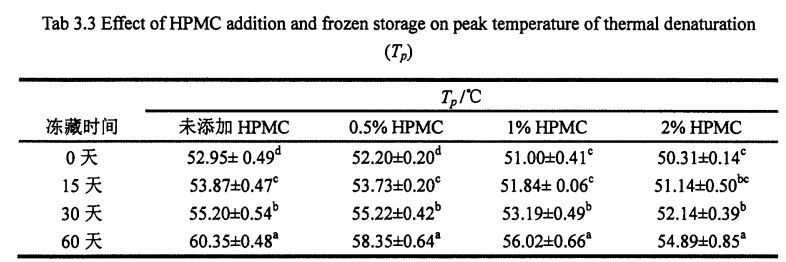
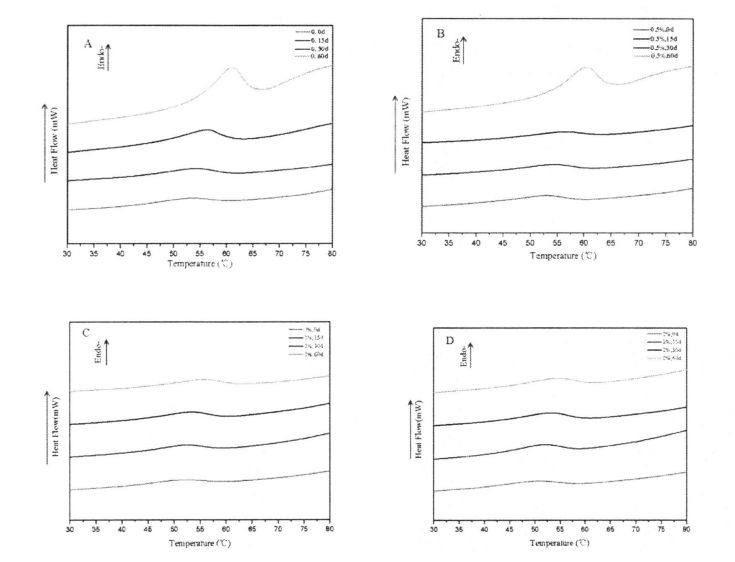
Fig 3.2 Typical DSC thermograms of gluten proteins with 0%HPMC(A);with O.5%HPMC(B); with 1%HPMC(C);with 2%HPMC(D)after different time of frozen storage,from 0d to 60d indicated from the lowest curve to the highest one in each graph. Dziwani: A ndi curve wa DCC Curve wa tirigu osatekesent popanda kuwonjezera HPMC; B ndi kuwonjezera kwa o. DCC Curve wa tirigu gluten ndi 5% hpmc; C ndi DSC Curve wa tirigu gluten ndi 1% hpmc; D is the DSC curve of wheat gluten with 2% HPMC 3.3.3 Effects of HPMC addition amount and freezing time on free sulfhydryl content (C-SH) Intermolecular and intramolecular covalent bonds are very important for the stability of dough network structure. Boma losokera (-Sss-) ndi mgwirizano wa Coovale wopangidwa ndi madzi am'madzi awiri aulere a sulfaphydll (.). Glutenin is composed of glutenin and gliadin, the former can form intramolecular and intermolecular disulfide bonds, while the latter can only form intramolecular disulfide bonds [1241] Therefore, disulfide bonds are an intramolecular/intermolecular disulfide bond. njira yofunika yolumikizirana. Compared to adding 0%, O. The C-SH of 5% and 1% HPMC without freezing treatment and the C-SH of gluten after 60 days of freezing have different degrees of increase respectively. Specifically, the face with no HPMC added gluten C. SH increased by 3.74 "mol/g to 8.25 "mol/g, while C.sh, shellfish, with gluten supplemented with 0.5% and 1% HPMC increased by 2.76 "mol/g to 7.25""mol/g and 1.33 "mol/g to 5.66 "mol/g (Fig. 3.3). Zhao, et a1. (2012) found that after 120 days of frozen storage, the content of free thiol groups increased significantly [ 1071. It is worth noting that the C-SH of gluten protein was significantly lower than that of other frozen storage periods when the freezing period was 15 days, which may be attributed to the freezing shrinkage effect of gluten protein structure, which makes the More intermolecular and intramolecular disulfide bonds were locally formed in a shorter freezing time [1161. Wang, et a1. (2014) found that the C-SH of glutenin-rich proteins was also significantly increased after 15 days of freezing. Decreased [1251. However, the gluten protein supplemented with 2% HPMC did not increase significantly except for C-SH, which also decreased significantly at 15 days, with the extension of freezing time.
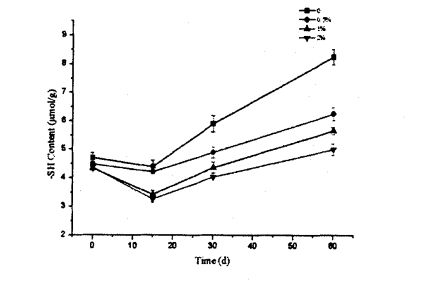
Mkuyu 3.3 Zotsatira za hpmc kuwonjezera pa zomwe zili kumasula kwa ma proterian, madzi ozizira amatha kupanga makhiristo oundana ndikugawa m'magawo a gluten. Therefore, with the prolongation of freezing time, the ice crystals become larger, which squeezes the gluten protein structure more seriously, and leads to the breakage of some intermolecular and intramolecular disulfide bonds, which increases the content of free sulfhydryl groups. On the other hand, the experimental results show that HPMC can protect the disulfide bond from the extrusion damage of ice crystals, thereby inhibiting the depolymerization process of gluten protein. 3.3.4 Effects of HPMC addition amount and freezing storage time on transverse relaxation time (T2) of wet gluten mass The distribution of Transverse Relaxation Time (T2) can reflect the model and dynamic process of water migration in food materials [6]. Figure 3.4 shows the distribution of wet gluten mass at 0 and 60 days with different HPMC additions, including 4 main distribution intervals, namely 0.1.1 ms (T21), 1.10 ms (T22), 10.100 ms (dead;) and 1 00-1 000 ms (T24). Bosmans et al. (2012) found a similar distribution of wet gluten mass [1261], and they suggested that protons with relaxation times below 10 ms could be classified as rapidly relaxing protons, which are mainly derived from poor mobility the bound water, therefore, may characterize the relaxation time distribution of bound water bound to a small amount of starch, while Dang may characterize the relaxation time distribution of bound water bound to gluten protein. In addition, Kontogiorgos (2007) - t11¨, the "strands" of the gluten protein network structure are composed of several layers (Sheets) about 5 nm apart, and the water contained in these layers is limited water (or Bulk water, phase water), the mobility of this water is between the mobility of bound water and free water. And T23 can be attributed to the relaxation time distribution of restricted water. The T24 distribution (>100 ms) has a long relaxation time, so it characterizes free water with strong mobility. This water exists in the pores of the network structure, and there is only a weak capillary force with the gluten protein system.
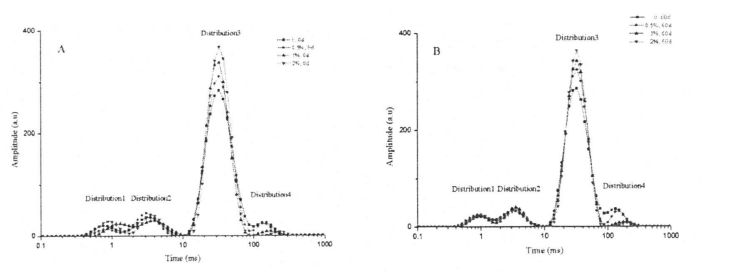
Chidziwitso: A ndi B akuimira nthawi yopuma (n) yogawa ma cuten a gpmc opangidwa ndi masiku a hpmc owonjezera kwa masiku 0 ndi masiku 60 osungirako osungira, motsatana
Kuyerekezera mtanda wonyowa wokhala ndi zowonjezera zosiyanasiyana za HPMC yosungidwa mu masiku 60 ndi kusasinthika kofananira kwa T21 ndi T24 yosungirako kuti kuwonjezera kwa HPMC sikunakulitse kuchuluka kwa madzi oyenera. content, which may be due to the fact that the main water-binding substances (gluten protein with a small amount of starch) were not significantly changed by the addition of a small amount of HPMC. Kumbali inayo, poyerekeza madera ogawidwa a T21 ndi T24 ya zonyowa misa ndi HPMC yofananira ndi nthawi yosiyanasiyana yopumira, zomwe zikuwonetsa kuti madzi oyenera osungirako osungirako, ndipo ali ndi zovuta zachilengedwe. Changes are less sensitive and less affected.
However, there were obvious differences in the height and area of T23 distribution of wet gluten mass that was not frozen and contained different HPMC additions, and with the increase of addition, the height and area of T23 distribution increased (Fig. 3.4). Kusintha kumeneku kumawonetsa kuti HPMC imatha kuwonjezera zogwirizana ndi madzi ochepa, ndipo zimalumikizidwa bwino ndi kuchuluka komweko mkati mwa mtundu winawake. Kuphatikiza apo, powonjezera nthawi yosungirako yosungirako, kutalika ndi dera la T23 kugawa kwa gluten misa yokhala ndi zomwezi ndi zomwezo zimachepa kwambiri. Chifukwa chake, poyerekeza ndi madzi omangidwa, madzi ochepa adawonetsa zovuta zina pakusunga kuzizira. Chidwi. This trend suggests that the interaction between the gluten protein matrix and the confined water becomes weaker. Izi zitha kukhala chifukwa magulu ambiri a Hydrophobic amawonekera mu kuzizira, komwe kumakhala kosasinthika ndi kutentha kwa matenthedwe. In particular, the height and area of the T23 distribution for the wet gluten mass with 2% HPMC addition did not show a significant difference. This indicates that HPMC can limit the migration and redistribution of water, and can inhibit the transformation of the water state from the restricted state to the free state during the freezing process.
Kuphatikiza apo, kutalika kwa T24 Kugawa kwa T24 kwa onyowa misa yokhala ndi mitundu ya HPMC kunali kosiyana kwambiri ndi kuchuluka kwa HPMC. This is just the opposite of the Dang distribution. Chifukwa chake, ulamuliro wa kusintha uku ukuwonetsa kuti HPMC ili ndi madzi omwe amagwira ntchito ndikusintha madzi aulere kuti asungunuke madzi. Komabe, patatha masiku 60 ozizira, kutalika ndi dera la kufala kwa T24 kudakula ku madigiri osiyanasiyana, omwe adawonetsa kuti malowo amasintha kuchokera kumadzi oletsedwa kuti asungunuke. This is mainly due to the change of the gluten protein conformation and the destruction of the "layer" unit in the gluten structure, which changes the state of the confined water contained in it. Although the content of freezable water determined by DSC also increases with the extension of freezing storage time, however, due to the difference in the measurement methods and characterization principles of the two, the freezable water and free water are not completely equivalent. Kwa onyowa gluten misa yowonjezera ndi 2% hpmc, atatha masiku 60 osungirako, zomwe zikuwonetsa kuti HPMC imasunganso madzi chifukwa chogwirizira madzi ndi gluten. and stable liquidity.
Generally speaking, the secondary structure of protein is divided into four types, α-Spiral, β-folded, β-Corners and random curls. The most important secondary bonds for the formation and stabilization of the spatial conformation of proteins are hydrogen bonds. Chifukwa chake, kutsutsidwa kwa protein ndi njira ya hydrogen Comment Kuswa ndi kusinthasintha.
Fourier transform infrared spectroscopy (FT-IR) has been widely used for high-throughput determination of the secondary structure of protein samples. The characteristic bands in the infrared spectrum of proteins mainly include, amide I band (1700.1600 cm-1), amide II band (1600.1500 cm-1) and amide III band (1350.1200 cm-1). Correspondingly, the amide I band the absorption peak originates from the stretching vibration of the carbonyl group (-C=O-.), the amide II band is mainly due to the bending vibration of the amino group (-NH-) [1271], and the amide III band is mainly due to the amino bending vibration and .CN-.Synchronous compound vibration in the same plane of bond Kutambasulira kugwedezeka, ndipo kumakhala ndi chidwi chachikulu cha ma protein sekondale kukhala (128'11291. Although the above three characteristic bands are all characteristic infrared absorption peaks of proteins, the specific In other words, the absorption intensity of amide II band is lower, so the semi-quantitative accuracy of protein secondary structure is poor; while the peak absorption intensity of amide I band is higher, so many researchers analyze the secondary structure of protein by this band [ 1301, but the absorption peak of water and the amide I band are overlapped at about 1640 cm. 1 Wawindi (wolunjika), omwe amakhudza zolondola pazotsatira. Chifukwa chake, madzi amalepheretsa kutsimikiza kwa Amider ine band mu sertein sekondale kukhala kutsimikiza kotsimikiza. In this experiment, in order to avoid the interference of water, the relative contents of four secondary structures of gluten protein were obtained by analyzing the amide III band. Malo obwera (mawonekedwe a ufa) a

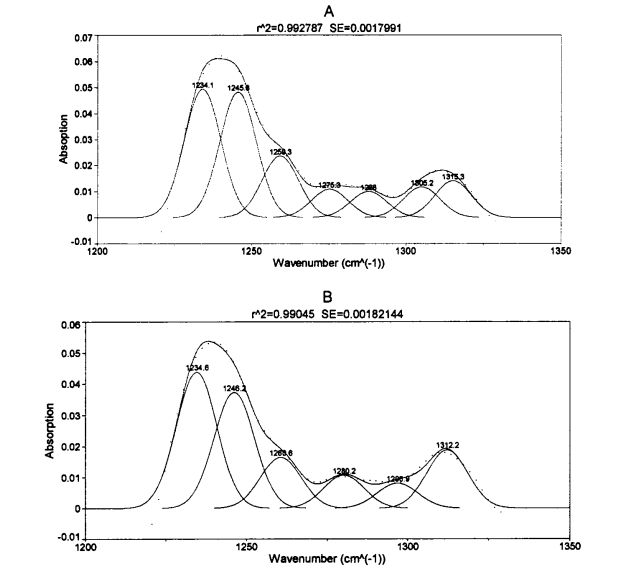
With the prolongation of frozen storage time, the secondary structure of gluten protein with different additions of HPMC changed to different degrees. It can be seen that both frozen storage and addition of HPMC have an effect on the secondary structure of gluten protein. Regardless of the amount of HPMC added, B. The folded structure is the most dominant structure, accounting for about 60%. After 60 days of frozen storage, add 0%, OB Gluten of 5% and 1% HPMC. The relative content of folds increased significantly by 3.66%, 1.87% and 1.16%, respectively, which was similar to the results determined by Meziani et al. (2011) [L33J]. However, there was no significant difference during frozen storage for gluten supplemented with 2% HPMC. In addition, when frozen for 0 days, with the increase of HPMC addition, p. Zomwe zili ndi zikondwerero zimachuluka pang'ono, makamaka pamene kuchuluka kwa 2%, p. Zomwe zili ndi zikondwerero zimachulukana ndi 2.01%. D. Kapangidwe kakulu ukhoza kugawidwa munthawi yapakati p. Kukulunga (chifukwa cha ma molekyulu a mapuloteni), antiparallel p. Adakulungidwa ndi kufanana p. Zigawo zitatu zimapindika, ndipo ndizovuta kudziwa zomwe zimachitika munthawi ya kuzizira
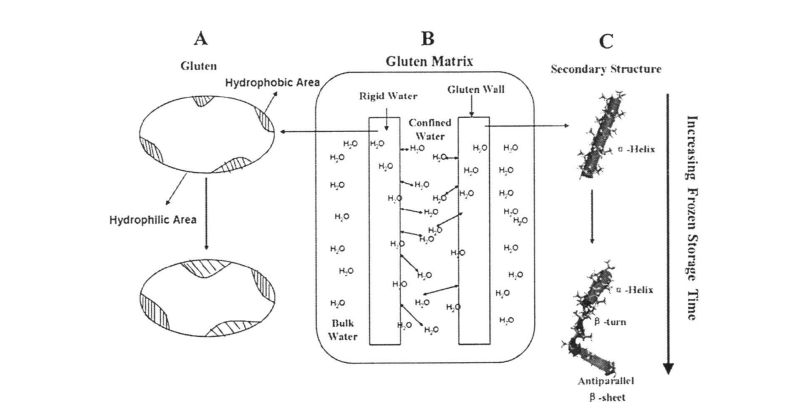
Kulongosoka kwachilengedwe kwa hydrophobic moussic modzindikira (a), kuwunikiranso madzi (b), komanso kusintha kwa seterral (c) mu gluten matrix ndi nthawi yowonjezera】
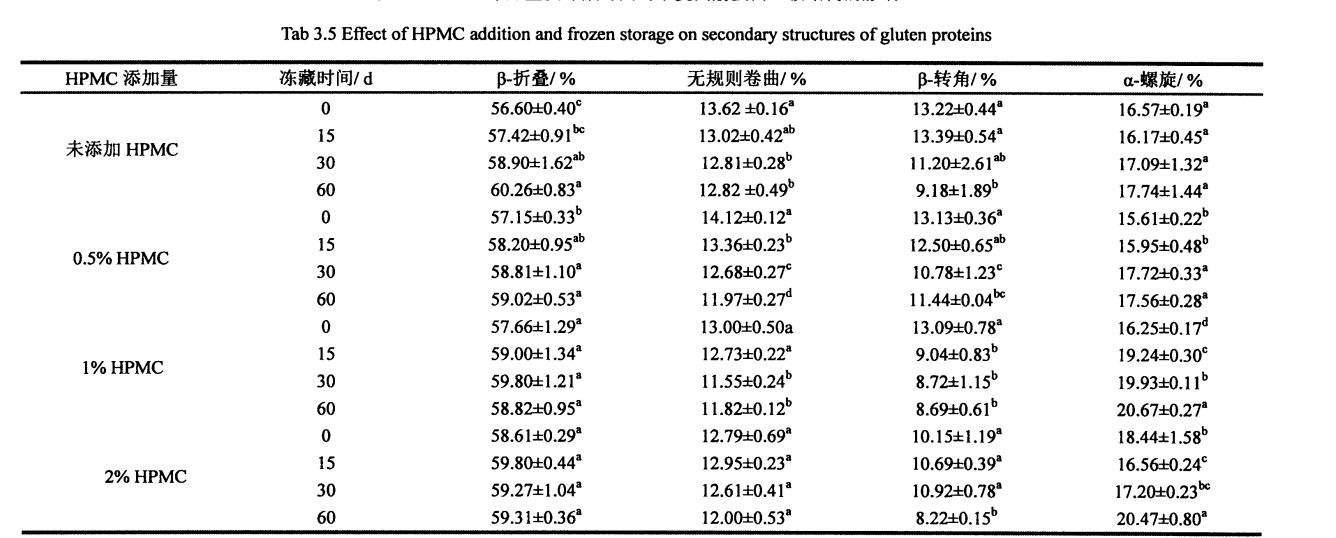
Zitsanzo zonse ndi kuwonjezera kwa nthawi yozizira, p. The relative contents of the corners were significantly reduced. Izi zikuwonetsa kuti kusintha kwa β kumathandiza kwambiri kuzizira kwaulere [135. 1361], and whether HPMC is added or not has no effect. Wellner, et A1. . Kupatula kuti wachibale yemwe ali ndi ma color osakhalitsa a gluten mapuloteni owonjezeredwa ndi 2% hpmc sanasinthe mosiyanasiyana, zitsanzo zina zimachepetsedwa kwambiri, zomwe zimatha kuchitika chifukwa cha makhiristo a Ice. Kuphatikiza apo, pomwe oundana kwa masiku 0, wachibale wa α-sheet ndi phy-posporte protein yowonjezera ndi 2% hpmc anali osiyana ndi mapuloteni osakhala ndi HPMC. Izi zitha kuwonetsa kuti pali kulumikizana pakati pa HPMC ndi mapuloteni atsopano, ndikupanga zomangira za haitegen kenako zimakhudzanso kutengera mapuloteni; Kapena HPMC imatenga madzi mu mawonekedwe a malo opanga mapuloteni, yomwe imaletsa mapuloteni ndipo imabweretsa kusintha kwambiri pakati pa agogo. Tsekani. The increase of the relative content of β-sheet structure and the decrease of the relative content of β-turn and α-helix structure are consistent with the above speculation. Panthawi yozizira, kusokonekera kwa madzi ndi mapangidwe a makristali a ayezi akuwononga magwiridwe antchito a hydrogen omwe amakhalabe okhazikika ndikuwonetsa magulu a hydrophobic a mapuloteni. Kuphatikiza apo, kuchokera pakuwona mphamvu, yaying'ono mphamvu ya mapuloteni, yomwe ili khola. Pa kutentha kochepa, kudzilimbitsa nokha (kukupinda ndi kuwulula kwa mamolekyu opanga mapuloteni kumangochitika zokha komanso kumabweretsa kusinthasintha.
Protein molecules include both hydrophilic and hydrophobic groups. Nthawi zambiri, mapuloteni apatekeni amapangidwa ndi magulu a hydrophilic, omwe amathamangira madzi olumikizira hydrogen kuti apange mamolekyulu a protein kuchokera ku zotupa ndikukhazikika. Mkati mwa mapuloteni ali ndi magulu ambiri a hydrophobic kuti apange ndi kusamalira kachiwiri ndi kapangidwe ka mapuloteni kudzera mu mphamvu ya hydrophobic. Denaturation of proteins is often accompanied by exposure of hydrophobic groups and increased surface hydrophobicity.
Tab3.6 zotsatira za hpmc kuwonjezera ndi zofunda zowundana pamtunda wa hydrophobicity wa gluten

Pambuyo masiku 60 osungirako ozizira, onjezani 0%, o. Makamaka. At the same time, after 60 days of frozen storage, the surface hydrophobicity of gluten protein added with different contents showed significant differences. However, after 60 days of frozen storage, the surface hydrophobicity of gluten protein added with 2% HPMC only increased from 19.749 to 26.995, which was not significantly different from the surface hydrophobicity value after 30 days of frozen storage, and was always lower than other the value of the surface hydrophobicity of the sample. This indicates that HPMC can inhibit the denaturation of gluten protein, which is consistent with the results of DSC determination of the peak temperature of heat deformation. This is because HPMC can inhibit the destruction of protein structure by recrystallization, and due to its hydrophilicity,
3.3. Zotsatira za HPMC Zowonjezera za HPMC ndi nthawi yosungirako malo osungirako za micro-network ya gluten
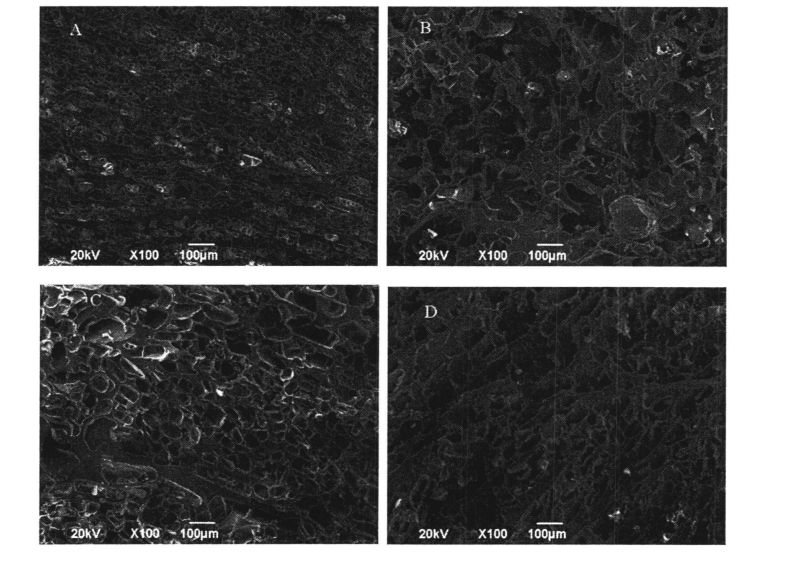
Zithunzi za microstruction wa gluten mtanda, (a) ufa wa gluten utoto wa 0d;
Dziwani: A ndi micrestruction ya gluten netiweki popanda kuwonjezera HPMC ndikuundana kwa masiku 0; B is the microstructure of gluten network without adding HPMC and frozen for 60 days; C is the microstructure of gluten network with 2% HPMC added and frozen for 0 days :D is the gluten network microstructure with 2% HPMC added and frozen for 60 days
Spornalogy yopweteka ngati morphology. Komabe, patatha masiku 60 a ozizira, maselo mu gluten microstle adakula, osasinthika, ndi ophatikizidwa ndi kuthyolako kwa "Khoma" Boma lodetsa, lomwe limakhudza mphamvu ndi umgwirizano wa kapangidwe kake. As reported by Kontogiorgos & Goff (2006) and Kontogiorgos (2007), the interstitial regions of the gluten network are squeezed due to freeze-shrinkage, resulting in structural disruption [138. 1391]. Kuphatikiza apo, chifukwa cha kuchepa thupi komanso kuvomerezedwa, mawonekedwe owoneka bwino amapangidwa mu spongy kapangidwe kake, womwe ungakhale chifukwa chochepetsera mu masiku 15 osungirako owundana, chifukwa zolumikizira zopangidwa ndi ziwazi. The gluten structure was not severely damaged for a shorter time, which is consistent with Wang, et a1. (2014) zindikirani zofananira zofananira [134]. Nthawi yomweyo, kuwonongedwa kwa micretect micretection kukhazikika kwa madzi ndi kuwunikiranso, komwe kumakhala kogwirizana ndi zotsatira za maginito otsika-a nyukiliya (TD-NMR). Some studies [140, 105] reported that after several freeze-thaw cycles, the gelatinization of rice starch and the structural strength of the dough became weaker, and the water mobility became higher. Komabe, patatha masiku 60 osungira ozizira, micrestrucy ya gluten ndi 2% hpmc kuwonjezera, ndi mawonekedwe ocheperako popanda glute yowonjezera (mkuyu. 3.). Izi zikuwonetsanso kuti HPMC imalepheretsa kuwonongeka kwa gluten kapangidwe kake kobweza.
Kuyesera kumeneku kunawunikira chinsinsi cha mtanda wonyowa ndi gluten protein powonjezera ma hpmc okhala ndi ma hpmc omwe ali ndi ma hpmc omwe ali ndi HPMC yokhala ndi ma freezing (0, 15, 30 ndi 60) masiku 60). Katundu, mafuta a thermodynamic, ndi zotsatira za madinitsi. The study found that the change and redistribution of water state during the freezing storage process significantly increased the freezable water content in the wet gluten system, which led to the destruction of the gluten structure due to the formation and growth of ice crystals, and ultimately caused the processing properties of the dough to be different. Deterioration of product quality. The results of frequency scanning showed that the elastic modulus and viscous modulus of the wet gluten mass without adding HPMC decreased significantly during the freezing storage process, and the scanning electron microscope showed that its microstructure was damaged. The content of free sulfhydryl group was significantly increased, and its hydrophobic group was more exposed, which made the thermal denaturation temperature and surface hydrophobicity of gluten protein significantly increased. However, the experimental results show that the addition of I-IPMC can effectively inhibit the changes in the structure and properties of wet gluten mass and gluten protein during freezing storage, and within a certain range, this inhibitory effect is positively correlated with the addition of HPMC. This is because HPMC can reduce the mobility of water and limit the increase of the freezable water content, thereby inhibiting the recrystallization phenomenon and keeping the gluten network structure and the spatial conformation of the protein relatively stable. Izi zikuwonetsa kuti kuwonjezera kwa HPMC kumatha kusungabe kukhulupirika kwa mtanda wowuma, potero kuonetsetsa kuti malonda akhale abwino.
MUTU 4 Zotsatira za Kuchulukitsa kwa HPMC pa kapangidwe kake ndi katundu wa wowuma pansi pa chofunda
Wowuma ndi wonenepa polysaride wokhala ndi shuga monga monomer. kiyi) mitundu iwiri. From a microscopic point of view, starch is usually granular, and the particle size of wheat starch is mainly distributed in two ranges of 2-10 pro (B starch) and 25-35 pm (A starch). From the perspective of crystal structure, starch granules include crystalline regions and amorphous regions (je, non-crystalline regions), and the crystal forms are further divided into A, B, and C types (it becomes V-type after complete gelatinization). Nthawi zambiri, dera la makristali limakhala ndi amylopectin ndipo dera la amorphous limakhala makamaka la amylose. This is because, in addition to the C chain (main chain), amylopectin also has side chains composed of B (Branch Chain) and C (Carbon Chain) chains, which makes amylopectin appear "tree-like" in raw starch. Maonekedwe a crystallite pamtengo umakonzedwa m'njira inayake kuti apange kristalo.
Starch is one of the main components of flour, and its content is as high as about 75% (dry basis). At the same time, as a carbohydrate widely present in grains, starch is also the main energy source material in food. In the dough system, starch is mostly distributed and attached to the network structure of gluten protein. Pakukonza ndi kusungira, nyenyezi nthawi zambiri zimakumana ndi gelatinization ndi magawo okalamba.
Among them, starch gelatinization refers to the process in which starch granules are gradually disintegrated and hydrated in a system with high water content and under heating conditions. Itha kugawidwa mosiyanasiyana kukhala njira zitatu zazikulu. 1) Madzi osintha madzi; before reaching the initial temperature of gelatinization, the starch granules in the starch suspension (Slurry) keep their unique structure unchanged, and the external shape and internal structure basically do not change. Only very little soluble starch is dispersed in the water and can be restored to its original state. 2) The irreversible water absorption stage; as the temperature increases, water enters the gap between the starch crystallite bundles, irreversibly absorbs a large amount of water, causing the starch to swell, the volume expands several times, and the hydrogen bonds between the starch molecules are broken. Imatambasulidwa ndipo makhiristo amazimiririka. At the same time, the birefringence phenomenon of starch, that is, the Maltese Cross observed under a polarizing microscope, begins to disappear, and the temperature at this time is called the initial gelatinization temperature of starch. 3) Starch granule disintegration stage; starch molecules completely enter the solution system to form starch paste (Paste/Starch Gel), at this time the viscosity of the system is the largest, and the birefringence phenomenon completely disappears, and the temperature at this time is called the complete starch gelatinization temperature, the gelatinized starch is also called α-starch [141]. When the dough is cooked, the gelatinization of starch endows the food with its unique texture, flavor, taste, color, and processing characteristics.
In general, starch gelatinization is affected by the source and type of starch, the relative content of amylose and amylopectin in starch, whether starch is modified and the method of modification, addition of other exogenous substances, and dispersion conditions (such as The influence of salt ion species and concentration, pH value, temperature, moisture content, etc.) [142-150]. Chifukwa chake, pomwe kapangidwe kawonda (mawonekedwe a morphology, malo ozungulira, etc.) imasinthidwa, katundu wa gelatinization, zotupa, etc.
Many studies have shown that the gel strength of starch paste decreases, it is easy to age, and its quality deteriorates under the condition of freezing storage, such as Canet, et a1. (2005) studied the effect of freezing temperature on the quality of potato starch puree; Ferrero, et a1. . Komabe, pali malipoti ochepa omwe ali ndi chisanu chosungira chowuma pa kapangidwe ka starch granules (mtundu wakufa), zomwe zikufunika kupitilizanso. Mtanda wozizira (kupatula ufa wophika wophika wachisanu) uli mu mawonekedwe a ma granure omangika pansi pa zomwe zimaphulika. Therefore, studying the structure and structural changes of native starch by adding HPMC has a certain effect on improving the processing properties of frozen dough. Kufunika.
Wheat Story Binzhou Zhongyu Chakudya CO., LTD.; HPMC Aladdin (Shanghai) Chemical Reagent Co., Ltd.;
BC / BD-272SC Fiririji
DHG. 9070
Kupanga
Jiangsu Jintan Jinheng Guosheng Resing Guvied
Live 1 g wa wowuma, kuwonjezera 9 ml ya madzi osungunuka, kugwedezeka kwathunthu ndikusakaniza kukonzekera 10% (W / W) kuyimitsidwa kolumala. Kenako ikani yankho la zitsanzo. 18 ℃ refrigerator, frozen storage for 0, 15 d, 30 d, 60 d, of which 0 day is the fresh control. Add 0.5%, 1%, 2% (w/w) HPMC instead of the corresponding quality starch to prepare samples with different addition amounts, and the rest of the treatment methods remain unchanged.
(1) mikhalidwe yopukutira gelatinization
Poyesera izi, rheoter idagwiritsidwa ntchito m'malo mwa wotchinjiri mwachangu kuti muyeze mawonekedwe a gelatinization. See Bae et a1. (2014) method [1571] with slight modifications. The specific program parameters are set as follows: use a plate with a diameter of 40 mill, the gap (gap) is 1000 mm, and the rotation speed is 5 rad/s; I) incubate at 50 °C for 1 min; ii) at 5. C/min heated to 95°C; iii) kept at 95°C for 2.5 min, iv) then cooled to 50°C at 5°C/min; v) lastly held at 50°C for 5 min.
Draw 1.5 mL of sample solution and add it to the center of the rheometer sample stage, measure the gelatinization properties of the sample according to the above program parameters, and obtain the time (min) as the abscissa, the viscosity (Pa s) and the temperature (°C) as the starch gelatinization curve of the ordinate. According to GB/T 14490.2008 [158], the corresponding gelatinization characteristic indicators—gelatinization peak viscosity (field), peak temperature (Ang), minimum viscosity (high), final viscosity (ratio) and decay value (Breakdown) are obtained. Mtengo, BV) ndi mtengo wobwezeretsanso (mtengo wobwerera, SV), momwe, komwe, mtengo wowuma = nsombu za mavidiyo - mawonekedwe owoneka; setback value = final viscosity - minimum viscosity. Samu iliyonse idabwerezedwa katatu.
(2) Kuyesa kokhazikika kwa stock stotte
The above gelatinized starch paste was subjected to the Steady Flow Test, according to the method of Achayuthakan & Suphantharika [1591, the parameters were set to: Flow Sweep mode, stand at 25°C for 10 min, and the shear rate scan range was 1) 0.1 S one. 100s ~, 2) 100s ~. 0.1 S~, the data is collected in logarithmic mode, and 10 data points (plots) are recorded every 10 times the shear rate, and finally the shear rate (Shear Rate, SI) is taken as the abscissa, and the shear viscosity ( Viscosity, pa ·s) is the rheological curve of the ordinate. Gwiritsani ntchito chiyambi 8.0 kuti mukwaniritse zoyenera zopindika za equation, ndipo chiwonetsero champhamvu), ndi yi, ndi n`, ndikuyenda mtsogolo).
Tengani 2.5 g amnjeni ndikusakaniza ndi madzi osungunuka mu chiwerengero cha 1: 2 kuti mupange ofunda. Freeze at 18°C for 15 d, 30 d, and 60 d. Onjezani 0,5, 1% hpmc (w / w) kuti musinthe wowuma mkhalidwe womwewo, ndipo njira zina zokonzekera sizingasinthe. After the freezing treatment is completed, take it out, equilibrate at 4 °C for 4 h, and then thaw at room temperature until it is tested.
Kenako, tsekani kuchuluka kwa oscillation, khazikitsani kuchuluka kwa zovuta (zovuta) mpaka 0.1% (malinga ndi zotsatira za strain), ndikuyika pafupipafupi kwa o. 1 mpaka 10 Hz. Each sample was repeated three times.
After the corresponding freezing treatment time, the samples were taken out, thawed completely, and dried in an oven at 40 °C for 48 h. Pomaliza, inali pansi pa vayi yokwanira 100-mes kuti ipeze zitsanzo zolimba kuti mugwiritse ntchito (yoyenera kuyesa kwa Xrd). Onani XIE, et A1. . Freeze at 18°C (0, 15, 30 and 60 days). Add 0.5%, 1%, 2% (w/w) HPMC to replace the corresponding quality of starch, and other preparation methods remain unchanged. Pambuyo posungira nthawi yosungirako yazizira yatha, tengani zoopsa komanso zofanana pa 4 ° C kwa 4 h.
Makina owuma owuma adawuma mu uvuni pa 40 ° C kwa 40 h, kenako nthaka ndi sivens yopanda mafayilo owuma. Take a certain amount of the above samples, use D/MAX 2500V type X. The crystal form and relative crystallinity were determined by X-ray diffractometer. Magawo oyesera ndi voliyumu 40 kv, yapano la 40 ma, pogwiritsa ntchito cu. Ma ks ngati X. Ray. At room temperature, the scanning angle range is 30--400, and the scanning rate is 20/min. Crystallity (%) = malo owerengera a crystallization x 100%, pomwe malo onsewo ndi gawo la dera lakumbuyo ndi malo ophatikizira a Peak [1 62].
4.2.6.6 kutsimikiza kwa mphamvu yotupa
Take 0.1 g of the dried, ground and sieved amyloid into a 50 mL centrifuge tube, add 10 mL of distilled water to it, shake it well, let it stand for 0.5 h, and then place it in a 95°C water bath at a constant temperature. After 30 min, after gelatinization is complete, take out the centrifuge tube and place it in an ice bath for 10 min for rapid cooling. Finally, centrifuge at 5000 rpm for 20 min, and pour off the supernatant to obtain a precipitate. Kutupa mphamvu = mpweya wambiri / zitsanzo misa [163].
Zoyesa zonse zinabwerezedwa kangapo katatu pokhapokha atatchulidwa, ndipo zoyesazi zidafotokozedwa ngati kupatuka. SPSS STATS 19 idagwiritsidwa ntchito powunikira kusiyanasiyana (kusanthula kwa kusiyanasiyana, kudzona) ndi gawo lofunikira la 0,05; Malemba olumikizana adakokedwa pogwiritsa ntchito chiyambi 8.0.
Malinga ndi GB 50093.2010, GB / T 5009.9.2008, Amylose / Amylopectin ndi Asylopectin adatsimikizika. Zotsatira zikuwonetsedwa mu tebulo 4. 1 Chowonetsedwa.

With 1% HPMC) and 393.614-45.94 CP (with 2% HPMC), the retrogradation value decreased from 403.60+6.13 CP (without HPMC) to 427.29+14.50 CP, respectively (0.5% HPMC added), 360.484-41.39 CP (15 HPMC added) and 357.85 + 21.00 CP (2% hpmc yowonjezera). This and the addition of hydrocolloids such as xanthan gum and guar gum obtained by Achayuthakan & Suphantharika (2008) and Huang (2009) can increase the gelatinization viscosity of starch while reducing the retrogradation value of starch. Izi zitha kukhala makamaka chifukwa HPMC imagwira ngati mtundu wa hydrophilic colloid, ndipo kuwonjezera kwa HPMC kumawonjezera mawonekedwe a gelatinic pachimake cha unyolo wake womwe umapangitsa kuti ikhale yopanda kutentha kwa firiji. Kuphatikiza apo, kutentha mitundu ya majertination gelatinization proces (thermogelation proctinition) ya HPMC ndikokulirapo kuposa kuwuma kwa HPMC kumatha kusokoneza kwambiri kutsika kwa ma victure chifukwa cha kusokonekera kwa granules. Chifukwa chake, mawonekedwe owoneka bwino komanso ma vinya omaliza a Stulat gelatinirization amawonjezeka pang'onopang'ono ndi kuchuluka kwa zomwe zili mu HPMC.
On the other hand, when the amount of HPMC added was the same, the peak viscosity, minimum viscosity, final viscosity, decay value and retrogradation value of starch gelatinization increased significantly with the extension of freezing storage time. Makamaka, nsonga mawidwe oyimitsidwa owuma osawonjezera hpmc yowonjezeredwa kuchokera ku 727.70. adding 0.5 The peak viscosity of starch suspension with %HPMC increased from 758.514-48.12 CP (freezing for 0 days) to 1415.834-45.77 CP (freezing for 60 days); Kuyimitsidwa kwa story ndi 1% hpmc komwe kukuwonjezera mawisi owoneka bwino kwa madzi owoneka bwino kwa 809.754-56.59 CP 78.19- Pomwe kuyimitsidwa kwa wowuma ndi 2% hpmc cp owonjezera gelatinirization nsonga ya 946.64 ± 940.224-94.06 cp (masiku 60). Nthawi yomweyo, mamasukidwe otsika kwambiri oyimitsidwa osayatsidwa ndi HPMC idachuluka kuchokera ku 391.02-41 8.97 cp (kuzizira kwa masiku 65.39 cp 2 60); Kuphatikiza 0,5 Kukweza Kwambiri kwa Kuyimitsidwa kwa Story Kuyimitsidwa ndi% HPMC Kuchulukitsidwa kuchokera 454.954-36.90 cp (kuzizira kwa masiku 60.22 CP); kuyimitsidwa kwa story ndi 1% hpmc komwe kukuwonjezera mawonekedwe ocheperako okwera kuchokera 485.564-54.05 cp (kuzizira kwa masiku 6); Pomwe kuyimitsidwa wowuma kunawonjezeredwa 2% hpmc cp gelationad Visct Gualict yotsika kwambiri kuchokera pa 553.03-55.57 cp 20.29 CP (60) ozizira).

Mawonekedwe omaliza a kuyimitsidwa osaneneka osawonjezera hpmc kuwonjezeka kuchokera ku 794.62 ± 45.15 cp 45.59 Kusunga kwa masiku 60). The peak viscosity of starch suspension increased from 882.24 ± 22.40 CP (frozen storage for 0 days) to 1322.86 ± 36.23 CP (frozen storage for 60 days); the peak viscosity of starch suspension added with 1% HPMC The viscosity increased from 846.04 ± 12.66 CP (frozen storage 0 days) to 1291.94 ± 88.57 CP (frozen storage for 60 days); and the gelatinization peak viscosity of starch suspension added with 2% HPMC increased from 91 0.88 ± 34.57 CP
. Correspondingly, the attenuation value of starch suspension without adding HPMC increased from 336.64 ± 71.73 CP (frozen storage for 0 days) to 1027.67 ± 38.72 CP (frozen storage for 60 days); adding 0.5 The attenuation value of starch suspension with %HPMC increased from 303.56±11.22 CP (frozen storage for 0 days) to 833.9±26.45 CP (frozen storage for 60 days); Kuyimitsidwa kwa story ndi 1% hpmc yowonjezera mtengo wamadzimadzi unawonjezeka kuchokera ku 324.19 ± 2.54 ± 107.71 cp (kuzizira kwa masiku 60); while adding 2% HPMC,the attenuation value of the starch suspension increased from 393.61 ± 45.94 CP (freezing for 0 days) to 557.64 ± 73.77 CP (freezing for 60 days); Pomwe kuyimitsidwa wowuma popanda HPMC kumawonjezera mtengo wobwereketsa kuchokera ku 403.60 ± 6.13 c
P (frozen storage for 0 days) to 856.38 ± 16.20 CP (frozen storage for 60 days); Kuyimitsa kwa Kuyimitsidwa kwa Wowuma Kumalumikiza ndi 0,5% HPMC Kuwonjezeredwa kuchokera 427 .25 ± 35.93 ± 3 60); the retrogradation value of starch suspension added with 1% HPMC increased from 360.48±41. 39 CP (frozen storage for 0 days) increased to 666.46 ± 21.40 CP (frozen storage for 60 days); Ngakhale kuyimitsidwa kwa storrathation kuyimitsidwa kwa 2% hpmc kuwonjezeka kuchokera ku 357.85 ± osungira (owundana owundana kwa masiku 60). 0 masiku) Kuchulukana mpaka 515.51 ± 20.86 cp (masiku 60) oundana).
It can be seen that with the prolongation of freezing storage time, the starch gelatinization characteristics index increased, which is consistent with Tao et a1. F2015) 1. Zogwirizana ndi zoyesazo, adapeza kuti ndi kuwonjezeka kwa chiwerengero cha kuchuluka kwa mizere yopukutira, komanso mtengo wocheperako, komanso kufunika kosinthika, komanso mtengo wopumira wa gelach tectionation yonse. This is mainly because in the process of freezing storage, the amorphous region (Amorphous Region) of starch granules is destroyed by ice crystallization, so that the amylose (the main component) in the amorphous region (non-crystalline region) undergoes phase separation (Phase. separated) phenomenon, and dispersed in the starch suspension, resulting in an increase in the viscosity of starch gelatinization, and an increase in the related attenuation value and retrogradation value. However, the addition of HPMC inhibited the effect of ice crystallization on starch structure. Chifukwa chake, mawonekedwe owoneka bwino, mawonekedwe ochepera, mawonekedwe omaliza, mtengo wowola komanso kuchuluka kwa zotupa za gelach gelatinization yotentha. increase and decrease sequentially.



Itha kuwoneka kuchokera pagome 4.3 kuti njira zonse zowoneka bwino, 2, ndizocheperapo 1. Chifukwa chake, ngati kulipidwa kapena ayi. In addition, the shear rate scans ranged from 0.1 s, respectively. 1 ochulukitsa mpaka 100 s ~, kenako ndikuchepetsa kuchokera ku 100 sd kwa o. Ma cucbologic mapves omwe adapezeka pa 1 sd sakuchulukirachulukira, kaya mulinso wowuma kapena ayi. However, under the same freezing storage time, with the increase of HPMC addition, the difference between the fitting results of the K n values of the two scans gradually decreased, which indicates that the addition of HPMC makes the structure of starch paste under shear stress. Imakhazikika pansi pa zomwe akuchita ndikuchepetsa mphete ya "Thihotropic"
On the other hand, for the starch without frozen storage, its K value decreased significantly with the addition of HPMC, from 78.240±1.661 Pa ·sn (without adding HPMC) to 65.240±1.661 Pa ·sn (without adding HPMC), respectively. 683 ± 1.035 pa · ST Tembenuzani. 310 ± 0,009 (kuwonjezera 0,5% hpmc), o. 323 ± 0,0 1% hpmc), of n value shows that the addition of HPMC makes the fluid has a tendency to change from pseudoplastic to Newtonian [168'1691]. at the same time, For the starch stored frozen for 60 days, the K, n values showed the same change rule with the increase of HPMC addition.
However, with the prolongation of freezing storage time, the values of K and n increased to different degrees, among which the value of K increased from 78.240 ± 1.661 Pa·sn (unadded, 0 days) to 95.570 ± 1, respectively. 2.421 Pa·sn (no addition, 60 days), increased from 65.683±1.035 Pa ·S n (addition of O. 5% HPMC, 0 days) to 51.384±1.350 Pa ·S n (Add to 0.5% HPMC, 60 days), increased from 43.122±1.047 Pa ·sn (adding 1% HPMC, 0 days) to 56.538 ± 1.378 pa · S SE STE (masiku 60))) 0.277 ± 0.011 (without adding HPMC, 0 days) rose to O. 334±0.014 (no addition, 60 days), increased from 0.310±0.009 (0.5% HPMC added, 0 day) to 0.336±0.014 (0.5% HPMC added, 60 days), from 0.323 ± 0.013 (add 1% HPMC, 0 0.340 ± 0,340 ± 0,013 (Onjezani 1-10) 1% hpmc, 0,020 hpmc, masiku 60). Poyerekeza, imatha kupezeka kuti ndi kuchuluka kwa hpmc, kusintha kwa kamodzi kwa K ndi mpeni kumachepetsa kuti kuwonjezera kwa HPMC kumatha mphamvu yolimba. zogwirizana.
Kupukusa pafupipafupi kumatha kuwonetsa bwino ma viscoelaoelaolity a zinthuzo, ndipo kuyika kuti kugwiritsidwa ntchito kumapangitsa mphamvu yake ya gel (gelve mphamvu). Chithunzi 4.3 akuwonetsa kusintha kwa kusungidwa modulus / elastic modulus (g ') ndi kutaya modulus / f ") yowuma kwambiri (g") nthawi yosiyanasiyana yosiyanasiyana.

Note: A is the change of viscoelasticity of unadded HPMC starch with the extension of freezing storage time; B is the addition of O. The change of viscoelasticity of 5% HPMC starch with the extension of freezing storage time; C ndikusintha kwa ma viscoelaty a 1% hpmc yowuma ndi kuwonjezera kwa nthawi yosungirako kwaulere; D ndikusintha kwa ma viscoelaus a 2% hpmc yowuma ndi kuchuluka kwa nthawi yosungirako yaulere
The starch gelatinization process is accompanied by the disintegration of starch granules, the disappearance of the crystalline region, and the hydrogen bonding between starch chains and moisture, the starch gelatinized to form a heat-induced (Heat. induced) gel with a certain gel strength. Monga taonera pa Chithunzi 4.3, kuti wowuma popanda chosungira, ndikuchulukitsa kwa HPMC, pomwe g "wonjezerani kuti ali ndi vuto la HPMC, zomwe zimawonekeranso Nthawi, chaisawang & Suphantharika (2005) adapeza kuti, kuwonjezera Guar Gum ndi nthawi yopukutira kwa madigiri ozizira, amyero mu Amorphous Dera la starch granules amalekanitsidwa ndikupanga wowuma wowuma (wowuma wowonongeka), omwe amachepetsa digiri ya kulumikizana kwa intermarpiner pambuyo pa kulumikizidwa kwa Starmor ndi digiri yolumikizirana. Stability and compactness, and the physical extrusion of ice crystals makes the arrangement of "micelles" (microcrystalline structures, mainly composed of amylopectin) in the starch crystallization area more compact, increasing the relative crystallinity of starch, and at the same time , resulting in insufficient combination of molecular chain and water after starch gelatinization, low extension of molecular chain (molecular chain Kusunthidwa), ndipo pamapeto pake anapangitsa kuti khungu lizikula bwino. However, with the increase of HPMC addition, the decreasing trend of G' was suppressed, and this effect was positively correlated with the addition of HPMC. This indicated that the addition of HPMC could effectively inhibit the effect of ice crystals on the structure and properties of starch under frozen storage conditions.
Chiwerengero chotupa chambiri chitha kuwonetsa kukula kwa gelatinization wowuma ndi kutupira kwamadzi, komanso kukhazikika kwa wowuma pa centrifugal. As shown in Figure 4.4, for starch without frozen storage, with the increase of HPMC addition, the swelling force of starch increased from 8.969+0.099 (without adding HPMC) to 9.282- -L0.069 (adding 2% HPMC), which shows that the addition of HPMC increases the swelling water absorption and makes starch more stable after gelatinization, which is consistent with the conclusion of starch gelatinization characteristics. However, with the extension of frozen storage time, the swelling power of starch decreased. Poyerekeza ndi masiku 0 osungira owundana, mphamvu yotupa ya skiar inatsika kuchokera mu 8.969 - A: 0.099 mpaka 7.057 + 0 pambuyo posungira kwa masiku 60, motero. .007. Zotsatira zake zidawonetsa kuti zowoneka bwino zam'madzi zidawonongeka pambuyo posungiramo madzi ozizira, zomwe zimapangitsa kuti mpweya ukhale wowuma komanso centrifugation. Chifukwa chake, kusungunuka kwa wopukutira kukuchulukirachulukira ndipo mphamvu zotupa zatha. Kuphatikiza apo, pambuyo pakuzizira kusungirako, stilach gelatar starchin wowuma, kukhazikika kwake ndi madzi okhala ndi mphamvu yochepa, ndipo kuphatikiza kwa awiriwa kunachepetsa mphamvu ya wowuma wa wowuma wambiri [1711]. Kumbali inayo, ndikuchulukitsa kwa HPMC, kuchepa kwa mphamvu yopukutira pang'onopang'ono, kuwonetsa kuti HPMC imachepetsa nthawi yosungirako ndikuletsa kuchuluka kwa zowonongeka za starch granule.
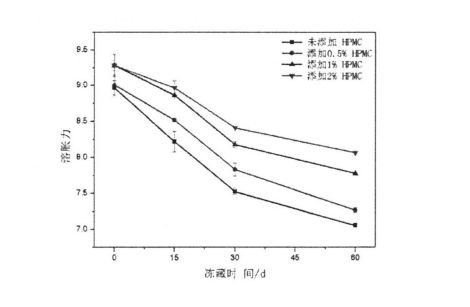
The gelatinization of starch is an endothermic chemical thermodynamic process. Therefore, DSC is often used to determine the onset temperature (Dead), peak temperature (To), end temperature (T p), and gelatinization enthalpy of starch gelatinization. (Tc). Gome 4.4 Imawonetsa DSC ma curves owuma gelatinization ndi 2% ndipo popanda HPMC yowonjezeredwa nthawi yosungirako yosungirako.
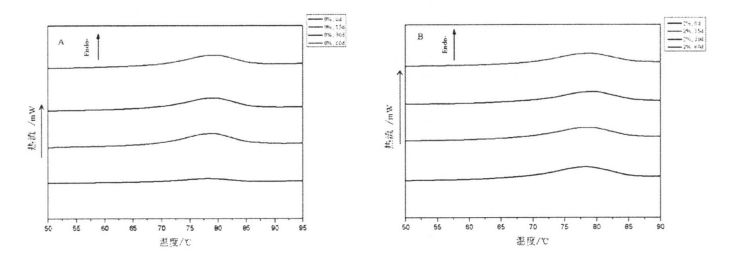
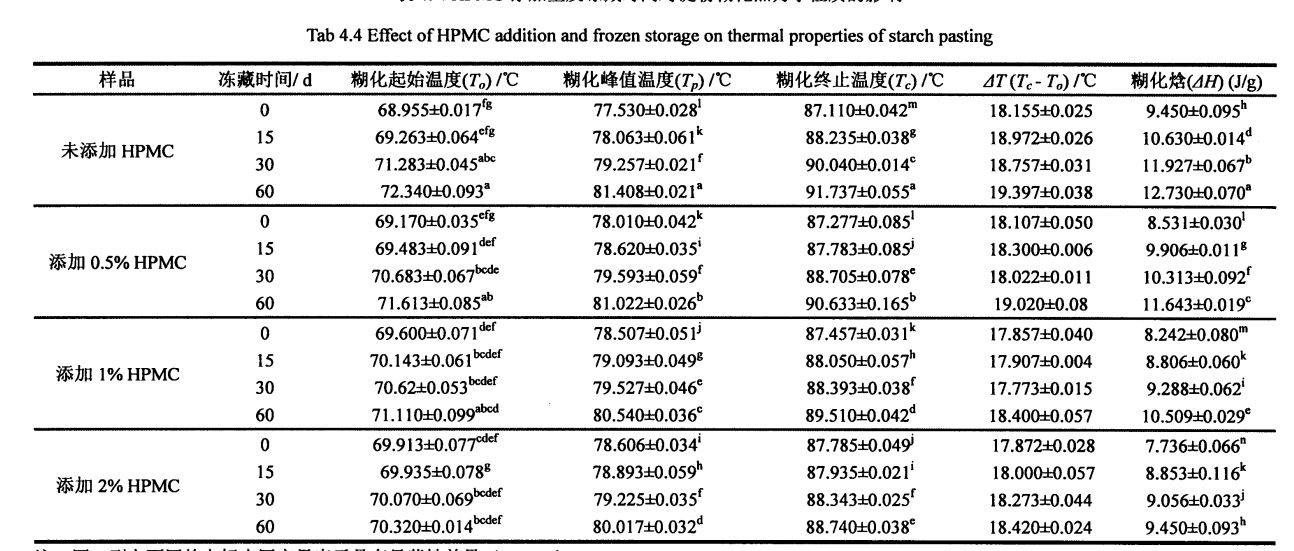
Monga taonera patebulo 4.4 0.034 (add 2% HPMC), but 4H is significant Decrease, from 9.450 ± 0.095 (without adding HPMC) to 8.53 ± 0.030 (adding 0.5% HPMC), 8.242A: 0.080 (adding 1% HPMC) and 7 .736 ± 0.066 (add 2% HPMC). Izi ndizofanana ndi zhou, et a1. (2008) found that adding a hydrophilic colloid decreased the starch gelatinization enthalpy and increased the starch gelatinization peak temperature [172]. Izi ndizomwe HPMC ili ndi hydrophilicity yabwino ndipo ndizosavuta kuphatikiza ndi madzi kuposa wowuma. At the same time, due to the large temperature range of the thermally accelerated gelation process of HPMC, the addition of HPMC increases the peak gelatinization temperature of starch, while the gelatinization Enthalpy decreases.
On the other hand, starch gelatinization To, T p, Tc, △T and △Hall increased with the extension of freezing time. Makamaka, kufalikira kwa gelatinir ndi 1% kapena 2% hpmc yowonjezeredwa pambuyo pozizira kwa masiku 60.955 ± 0,095 ± days) to 71.613 ± 0.085 (frozen storage for 0 days) 60 days); Pambuyo masiku 60 osungidwa owundana, kukula kwa matenda owuma kwa gelatinization kunachepa ndi kuwonjezera kwa HPMC, monga wowuma popanda HPMC yowonjezeredwa kuchokera ku 77.530 ± 0,028 (ophukira kwa masiku) mpaka 81.028. 408 ± 0,021 (Kusunga kwa Achisanu kwa masiku 60), pomwe wosuta adawonjezera ndi 2% hpmc owonjezereka kuchokera ku 78.606 ± 0,034 ± masiku); Kuphatikiza apo, Δh adawonetsanso lamulo lomwelo, lomwe limakwera kuchokera ku 9.450 ± 0,430 ± 0,430 ± 0,430 ± 0,430 ± 0,430 ± 0,430 ± 0,430 ± 0,430 ± 0,430 ± 0,430 ± 0,430 ± 531 ± 0,030 (kuwonjezera 0,5%, masiku 0.643 ± 0,5% (2%), masiku 6.093 (2% kuwonjezera, masiku 60). Zifukwa zazikulu zosinthira zomwe zatchulidwazi mu thermodynamic katundu wa gelatal gelatinization nthawi yopumira ndikupanga dera lowonongeka, lomwe limawononga dera la amorphous) ndikuwonjezera makrishine a Crystalline. The coexistence of the two increases the relative crystallinity of starch, which in turn leads to an increase in thermodynamic indexes such as starch gelatinization peak temperature and gelatinization enthalpy. However, through comparison, it can be found that under the same freezing storage time, with the increase of HPMC addition, the increase of starch gelatinization To, T p, Tc, ΔT and ΔH gradually decreases. It can be seen that the addition of HPMC can effectively maintain the relative stability of the starch crystal structure, thereby inhibiting the increase of the thermodynamic properties of starch gelatinization.
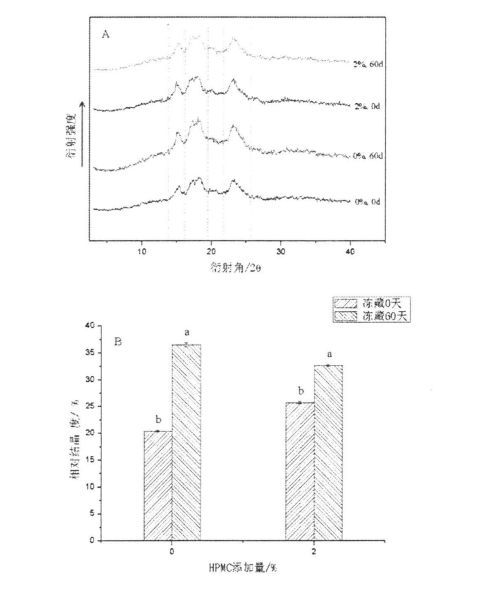
Wowuma ndiye chinthu chowuma chochuluka kwambiri mu mtanda, chomwe, pambuyo pa gelatinization, chimawonjezera mawonekedwe apadera (voliyumu yapadera (kapangidwe kake, kapangidwe kake, zonunkhira, ndi zina) ku mtanda. Popeza kusintha kwa chouma kumakhudzanso mikhalidwe yake ya gelatinization, komwe kumakhudzanso zinthu za ufa, zomwe zimayesedwa, zimapangitsa kuti kuwuma ufa ukhale wosungunuka kwa HPMC yowonjezera. Zosintha pazachuma, thermodynamic katundu ndi mawonekedwe a kristalo adagwiritsidwa ntchito kuwunika njira yoteteza HPMC pa mawonekedwe ophatikizika ndi katundu wokhudzana. The experimental results showed that after 60 days of frozen storage, the starch gelatinization characteristics (peak viscosity, minimum viscosity, final viscosity, decay value and retrogradation value) all increased due to the significant increase in the relative crystallinity of starch and the increase in the content of damaged starch. A Gelatinurization orkpy onjezerani, pomwe kulimba kwa gel kumapangidwira wowuma uku unachepa kwambiri; however, especially the starch suspension added with 2% HPMC, the relative crystallinity increase and starch damage degree after freezing were lower than those in the control group Therefore, the addition of HPMC reduces the degree of changes in gelatinization characteristics, gelatinization enthalpy, and gel strength, which indicates that the addition of HPMC keeps the starch structure and its gelatinization properties relatively stable.
5.2.1 Zida ndi zida
Ultra-kuyeretsa steriyation tebulo logwira ntchito
Kupanga
5.2.2 Kukonzekera kwa yisiti
Weigh 3 g of active dry yeast, add it to a sterilized 50 mL centrifuge tube under aseptic conditions, and then add 27 mL of 9% (w/V) sterile saline to it, shake it up, and prepare 10% (w/w) yeast broth. Kenako, kusamukira mwachangu. Sungani mufiriji pa 18 ° C. Pambuyo pa 15 d, 30 d, ndi 60 d ya owundana yowundana, zitsanzozo zidatengedwa. Add 0.5%, 1%, 2% HPMC (w/w) to replace the corresponding percentage of active dry yeast mass. In particular, after the HPMC is weighed, it must be irradiated under an ultraviolet lamp for 30 minutes for sterilization and disinfection.
Imbani 1 g wa mtanda, onjezerani chubu choyesera ndi 9 ml ya osabala mchere, ndikuugwedeza chidwi cha magawo 101, kenako ndikuwuza magawo angapo a 10'a. Draw 1 mL of dilution from each of the above tubes, add it to the center of the 3M yeast rapid count test piece (with strain selectivity), and place the above test piece in a 25°C incubator according to the operating requirements and culture conditions specified by 3M. 5 d, take out after the end of the culture, first observe the colony morphology to determine whether it conforms to the colony characteristics of yeast, and then count and microscopically examine [179]. Each sample was repeated three times.

As shown in Figure 5.1, when frozen for 0 days, with the increase in the amount of HPMC added, the proofing height of the dough increased from 4.234-0.11 cm to 4.274 cm without adding HPMC. -0.12 cm (0.5% HPMC added), 4.314-0.19 cm (1% HPMC added), and 4.594-0.17 cm (2% HPMC added) This may be mainly due to HPMC Addition changes the properties of the dough network structure (see Chapter 2). However, after being frozen for 60 days, the proofing height of the dough decreased to varying degrees. Makamaka, chitsimikiziro chotsimikizika cha mtanda popanda kuchepetsedwa kuchokera pa 4,234-0.11 cm (kuzizira kwa masiku 0) mpaka 3.18 masentimita (owundana owundana kwa masiku 60); Mtanda wowonjezedwa ndi 0,5% hpmc adachepetsedwa kuchokera ku 4.27 + 0.12 masentimita (ozizira osungira kwa masiku 0) mpaka 3.424-0.22 masentimita (owundana). Masiku 60); the dough added with 1% HPMC decreased from 4.314-0.19 cm (frozen storage for 0 days) to 3.774-0.12 cm (frozen storage for 60 days); while the dough added with 2% HPMC woke up. The hair height was reduced from 4.594-0.17 cm (frozen storage for 0 days) to 4.09-±0.16 cm (frozen storage for 60 days). Itha kuwoneka kuti ndi kuchuluka kwa hpmc, kuchuluka kwa kuchepa kwa chiwonetsero cha mtanda pang'onopang'ono kumachepa. Izi zikuwonetsa kuti pamalo osungirako achisanu, hpmc silingangokhalabe ndi kukhazikika kwa chiwongola dzanja cha yisiti, komanso nkosandulika kukhazikika kwa yisiti ndi ntchito yopanga mpweya, potero kuchepetsa kuwonongeka kwa Zakudyazi zopserera.
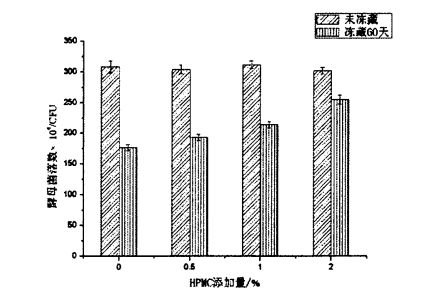
Mkuyu wa 5.2
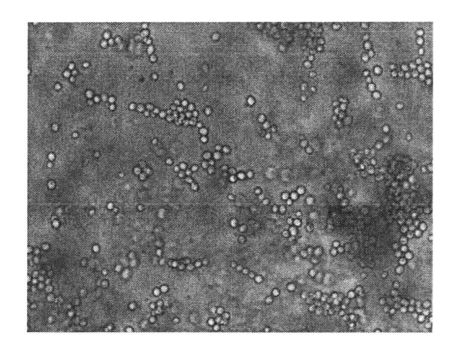
5.3. Zotsatira za zowonjezera za HPMC ndi nthawi yozizira pa glutathone mu mtanda
Slutath ndi malo obiriwira opangidwa ndi glutamic acid, Cysteine ndi glycine, ndipo ali ndi mitundu iwiri: ochepetsedwa komanso ochepetsedwa komanso ochepetsedwa. Kapangidwe ka yisiti utawonongeka ndikufa, kuchuluka kwa maselo kumawonjezeka, ndipo umeracellular sutath imatulutsidwa kunja kwa cell, ndipo zimabwezera. It is particularly worth noting that reduced glutathione will reduce the disulfide bonds (-SS-) formed by the cross-linking of gluten proteins, breaking them to form free sulfhydryl groups (.SH), which in turn affects the dough network structure. stability and integrity, and ultimately lead to the deterioration of the quality of fermented flour products. Usually, under environmental stress (such as low temperature, high temperature, high osmotic pressure, etc.), yeast will reduce its own metabolic activity and increase its stress resistance, or produce spores at the same time. When the environmental conditions are suitable for its growth and reproduction again, then restore the metabolism and proliferation vitality. However, some yeasts with poor stress resistance or strong metabolic activity will still die if they are kept in a frozen storage environment for a long time.
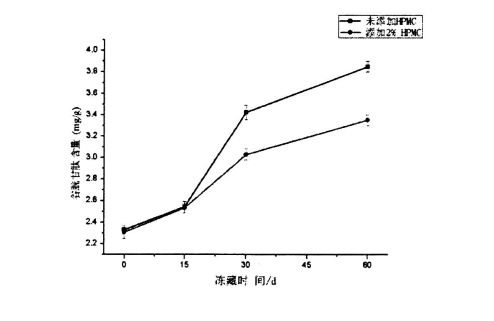
As shown in Figure 5.4, the glutathione content increased regardless of whether HPMC was added or not, and there was no significant difference between the different addition amounts. Izi zitha kukhala chifukwa ena mwa yisiti yowuma yomwe amagwiritsa ntchito mtanda alibe kupsinjika ndi kulekerera. Under the condition of low temperature freezing, the cells die, and then glutathione is released, which is only related to the characteristics of the yeast itself. Zimakhudzana ndi chilengedwe chakunja, koma ilibe chochita ndi kuchuluka kwa hpmc yowonjezera. Chifukwa chake, zomwe zili ndi mafuta ochulukitsidwa masiku 15 ozizira ndipo kunalibe kusiyana kwakukulu pakati pa awiriwo. However, with the further extension of the freezing time, the increase of glutathione content decreased with the increase of HPMC addition, and the glutathione content of the bacterial solution without HPMC was increased from 2.329a: 0.040mg/ g (frozen storage for 0 days) increased to 3.8514-0.051 mg/g (frozen storage for 60 days); while the yeast liquid added 2% HPMC, its glutathione content increased from 2.307+0 .058 mg/g (frozen storage for 0 days) rose to 3.351+0.051 mg/g (frozen storage for 60 days). Izi zidawonetsanso kuti HPMC ikhoza kuteteza maselo anu ndikuchepetsa yisiti, potero kuchepetsa zomwe zili mu hutath. Izi zimapangitsa kuti HPMC imatha kuchepetsa kuchuluka kwa ma aices a Ice, potero kuchepetsa nkhawa za makhiristo a Ice ku yisiti ndikulepheretsa kuwonjezeka kwa kutupa kwa kachilombo ka sutathone.
Yeast is an indispensable and important component in fermented flour products, and its fermentation activity will directly affect the quality of the final product. In this experiment, the protective effect of HPMC on yeast in frozen dough system was evaluated by studying the effect of different HPMC additions on yeast fermentation activity, yeast survival number, and extracellular glutathione content in frozen dough. Chifukwa cha zoyeserera, zidapezeka kuti kuwonjezera kwa HPMC kumatha kukhalabe ndi mphamvu ya yisiti, ndikuchepetsa kuchepa kwa chiwonetsero cha patatha masiku 60 ozizira kwambiri; in addition, the addition of HPMC effectively The decrease of yeast survival number was inhibited and the increase rate of reduced glutathione content was reduced, thereby alleviating the damage of glutathione to dough network structure. Izi zikusonyeza kuti HPMC imatha kuteteza yisiti poletsa mapangidwe ndi kukula kwa makhiristo a ice.
Post Nthawi: Oct-08-2022







